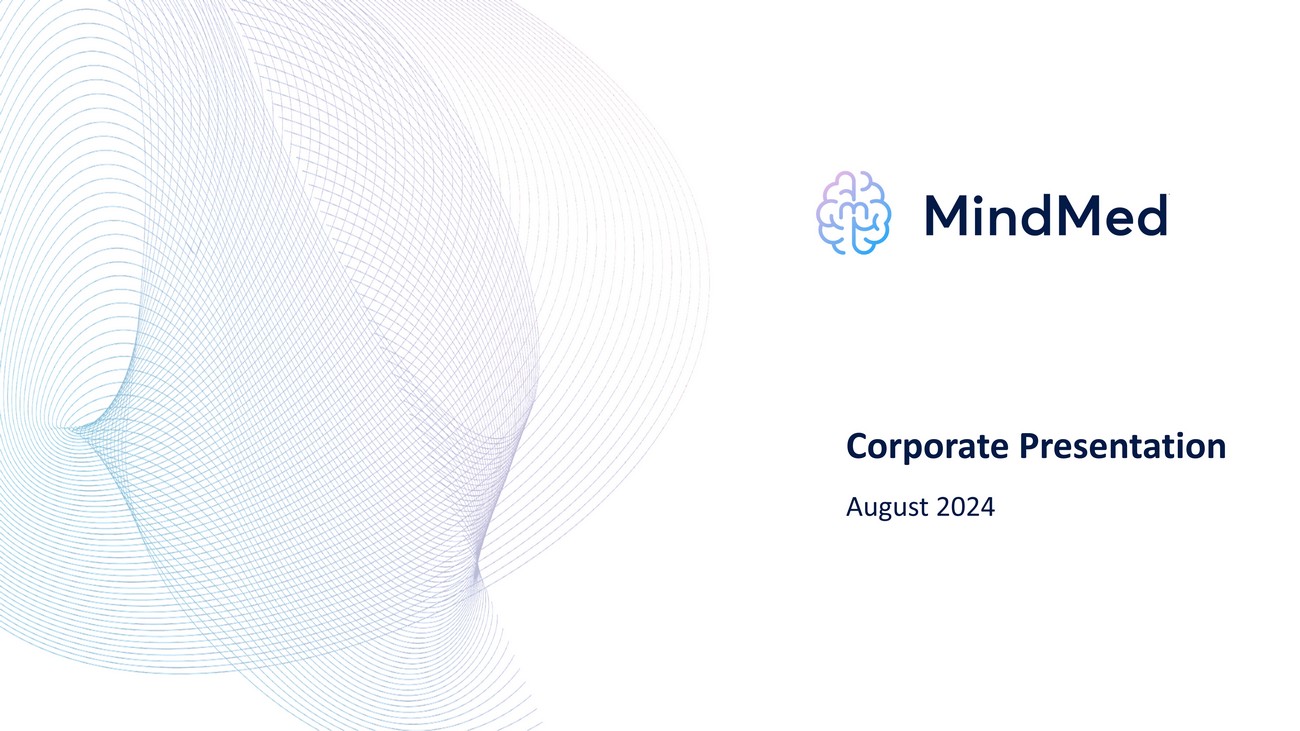
Exhibit 99.3

Corporate Presentation August 2024
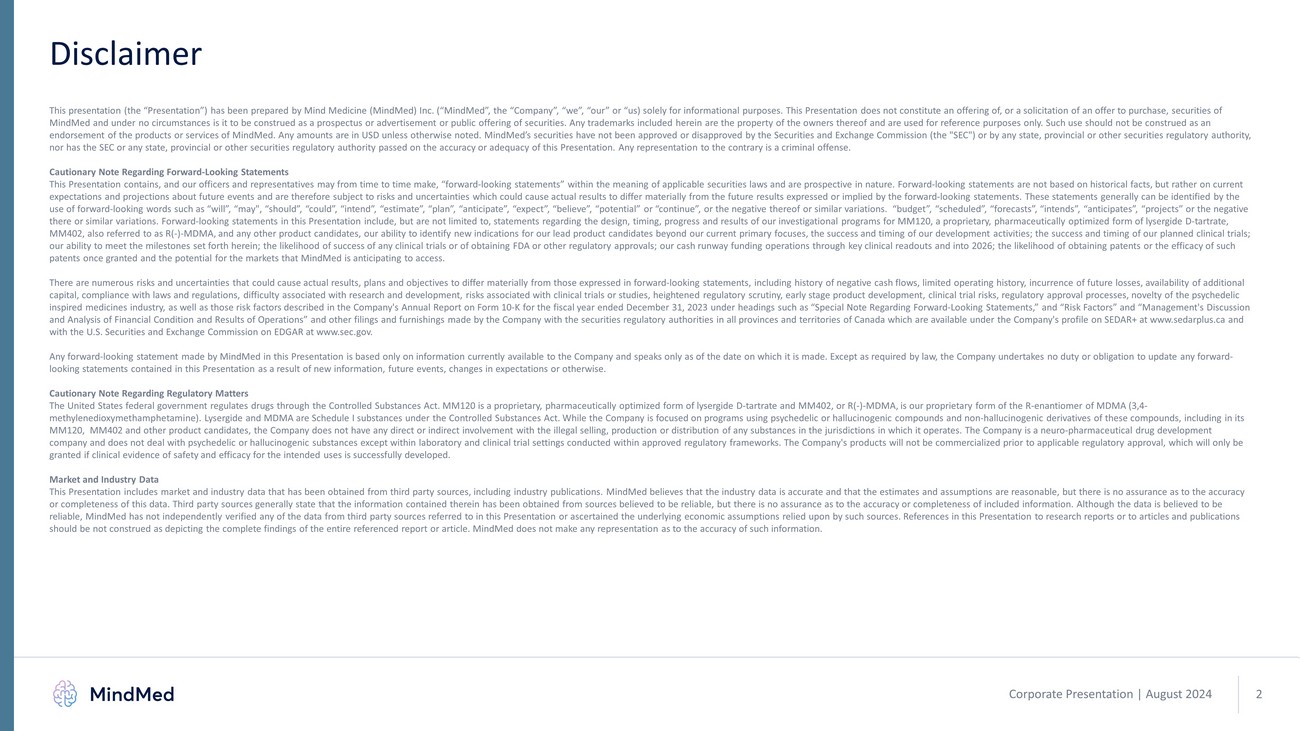
Corporate Presentation | August 2024 Disclaimer This presentation (the “Presentation”) has been prepared by Mind Medicine ( MindMed ) Inc. (“ MindMed ”, the “Company”, “we”, “our” or “us) solely for informational purposes. This Presentation does not constitute an offering of , o r a solicitation of an offer to purchase, securities of MindMed and under no circumstances is it to be construed as a prospectus or advertisement or public offering of securities. Any trade ma rks included herein are the property of the owners thereof and are used for reference purposes only. Such use should not be c ons trued as an endorsement of the products or services of MindMed . Any amounts are in USD unless otherwise noted. MindMed’s securities have not been approved or disapproved by the Securities and Exchange Commission (the "SEC") or by any state, provi nc ial or other securities regulatory authority, nor has the SEC or any state, provincial or other securities regulatory authority passed on the accuracy or adequacy of this Pre sentation. Any representation to the contrary is a criminal offense. Cautionary Note Regarding Forward - Looking Statements This Presentation contains, and our officers and representatives may from time to time make, “forward - looking statements” within the meaning of applicable securities laws and are prospective in nature. Forward - looking statements are not based on historical facts, but rather on current expectations and projections about future events and are therefore subject to risks and uncertainties which could cause actua l r esults to differ materially from the future results expressed or implied by the forward - looking statements. These statements gen erally can be identified by the use of forward - looking words such as “will”, “may", “should”, “could”, “intend”, “estimate”, “plan”, “anticipate”, “expect”, “be lieve”, “potential” or “continue”, or the negative thereof or similar variations. “budget”, “scheduled”, “forecasts”, “inten ds” , “anticipates”, “projects” or the negative there or similar variations. Forward - looking statements in this Presentation include, but are not limited to, statements regardi ng the design, timing, progress and results of our investigational programs for MM120, a proprietary, pharmaceutically optimi zed form of lysergide D - tartrate, MM402, also referred to as R( - ) - MDMA, and any other product candidates, our ability to identify new indications for our lead pro duct candidates beyond our current primary focuses, the success and timing of our development activities; the success and tim ing of our planned clinical trials; our ability to meet the milestones set forth herein; the likelihood of success of any clinical trials or of obtaining FDA or oth er regulatory approvals; our cash runway funding operations through key clinical readouts and into 2026; the likelihood of ob tai ning patents or the efficacy of such patents once granted and the potential for the markets that MindMed is anticipating to access. There are numerous risks and uncertainties that could cause actual results, plans and objectives to differ materially from th ose expressed in forward - looking statements, including history of negative cash flows, limited operating history, incurrence of fut ure losses, availability of additional capital, compliance with laws and regulations, difficulty associated with research and development, risks associated with cli nic al trials or studies, heightened regulatory scrutiny, early stage product development, clinical trial risks, regulatory appro val processes, novelty of the psychedelic inspired medicines industry, as well as those risk factors described in the Company's Annual Report on Form 10 - K for the fiscal year ended December 31, 2023 under headings such as “Special Note Regarding Forward - Looking Statements,” and “Risk Factors” and “Management's Discussion and Analysis of Financial Condition and Results of Operations” and other filings and furnishings made by the Company with the se curities regulatory authorities in all provinces and territories of Canada which are available under the Company's profile on SE DAR+ at www.sedarplus.ca and with the U.S. Securities and Exchange Commission on EDGAR at www.sec.gov. Any forward - looking statement made by MindMed in this Presentation is based only on information currently available to the Company and speaks only as of the date on which it is made. Except as required by law, the Company undertakes no duty or obligation to update any forward - looking statements contained in this Presentation as a result of new information, future events, changes in expectations or o the rwise. Cautionary Note Regarding Regulatory Matters The United States federal government regulates drugs through the Controlled Substances Act. MM120 is a proprietary, pharmaceu tic ally optimized form of lysergide D - tartrate and MM402, or R( - ) - MDMA, is our proprietary form of the R - enantiomer of MDMA (3,4 - methylenedioxymethamphetamine). Lysergide and MDMA are Schedule I substances under the Controlled Substances Act. While the Company is focused on programs using psyche de lic or hallucinogenic compounds and non - hallucinogenic derivatives of these compounds, including in its MM120, MM402 and other product candidates, the Company does not have any direct or indirect involvement with the illegal sel lin g, production or distribution of any substances in the jurisdictions in which it operates. The Company is a neuro - pharmaceutical drug development company and does not deal with psychedelic or hallucinogenic substances except within laboratory and clinical trial settings con ducted within approved regulatory frameworks. The Company's products will not be commercialized prior to applicable regulator y a pproval, which will only be granted if clinical evidence of safety and efficacy for the intended uses is successfully developed. Market and Industry Data This Presentation includes market and industry data that has been obtained from third party sources, including industry publi cat ions. MindMed believes that the industry data is accurate and that the estimates and assumptions are reasonable, but there is no assurance as to the accuracy or completeness of this data. Third party sources generally state that the information contained therein has been obtained fr om sources believed to be reliable, but there is no assurance as to the accuracy or completeness of included information. Althou gh the data is believed to be reliable, MindMed has not independently verified any of the data from third party sources referred to in this Presentation or ascertained the u nd erlying economic assumptions relied upon by such sources. References in this Presentation to research reports or to articles and publications should be not construed as depicting the complete findings of the entire referenced report or article. MindMed does not make any representation as to the accuracy of such information. 2
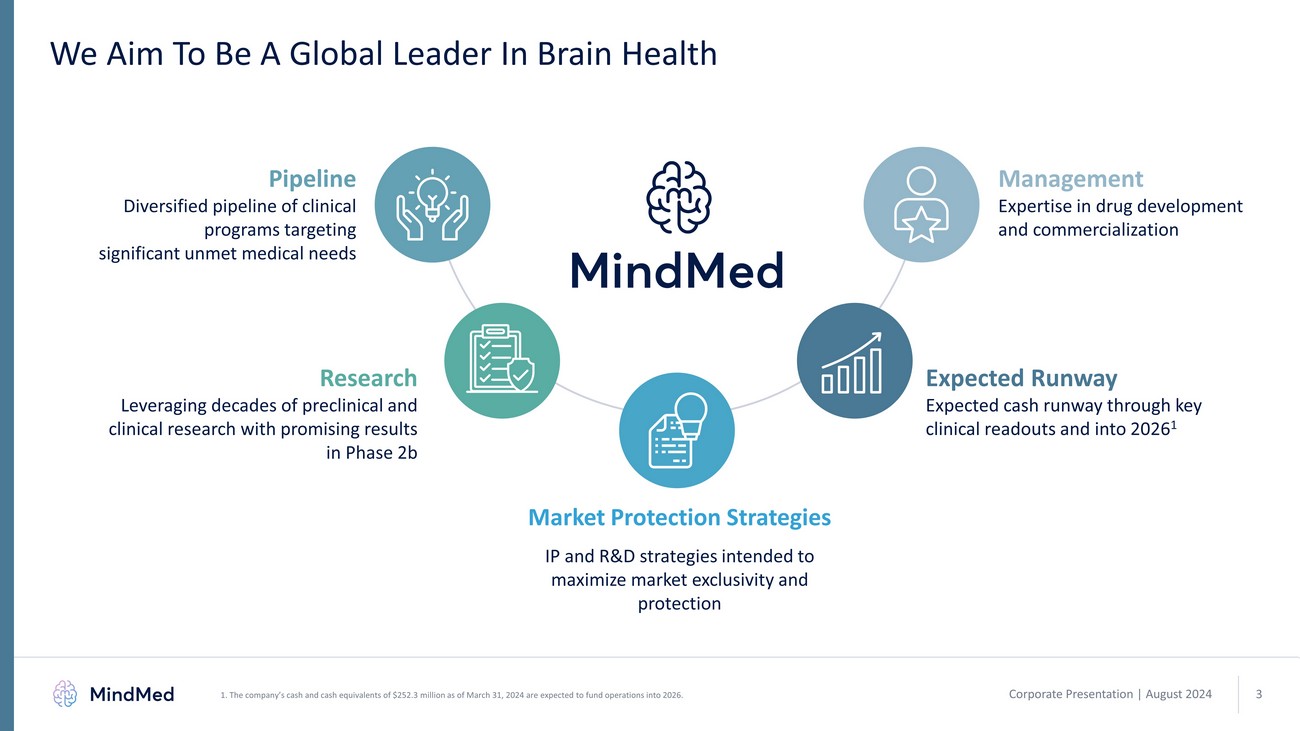
Corporate Presentation | August 2024 We Aim To Be A Global Leader In Brain Health 1. The company’s cash and cash equivalents of $252.3 million as of March 31, 2024 are expected to fund operations into 2026. Pipeline Diversified pipeline of clinical programs targeting significant unmet medical needs Research Leveraging decades of preclinical and clinical research with promising results in Phase 2b IP and R&D strategies intended to maximize market exclusivity and protection Expected Runway Expected cash runway through key clinical readouts and into 2026 1 Management Expertise in drug development and commercialization Market Protection Strategies 3
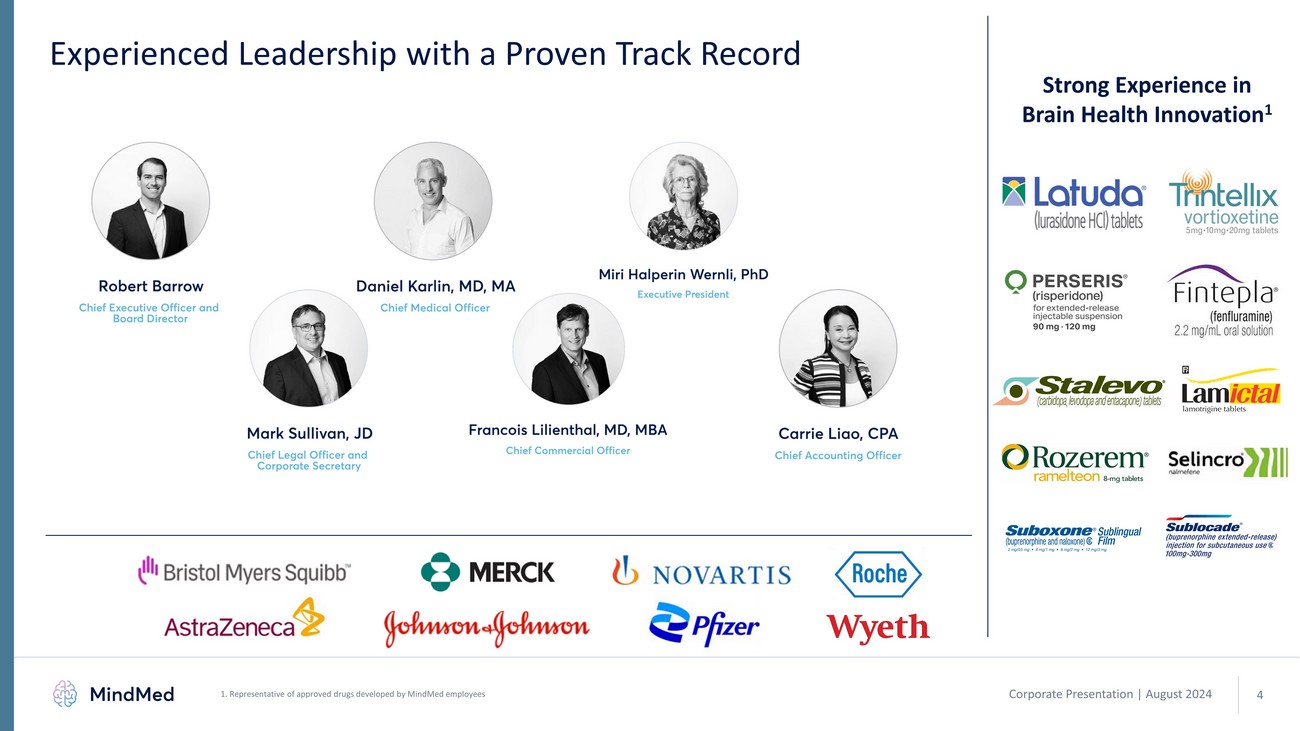
Corporate Presentation | August 2024 Experienced Leadership with a Proven Track Record 4 Strong Experience in Brain Health Innovation 1 1. Representative of approved drugs developed by MindMed employees
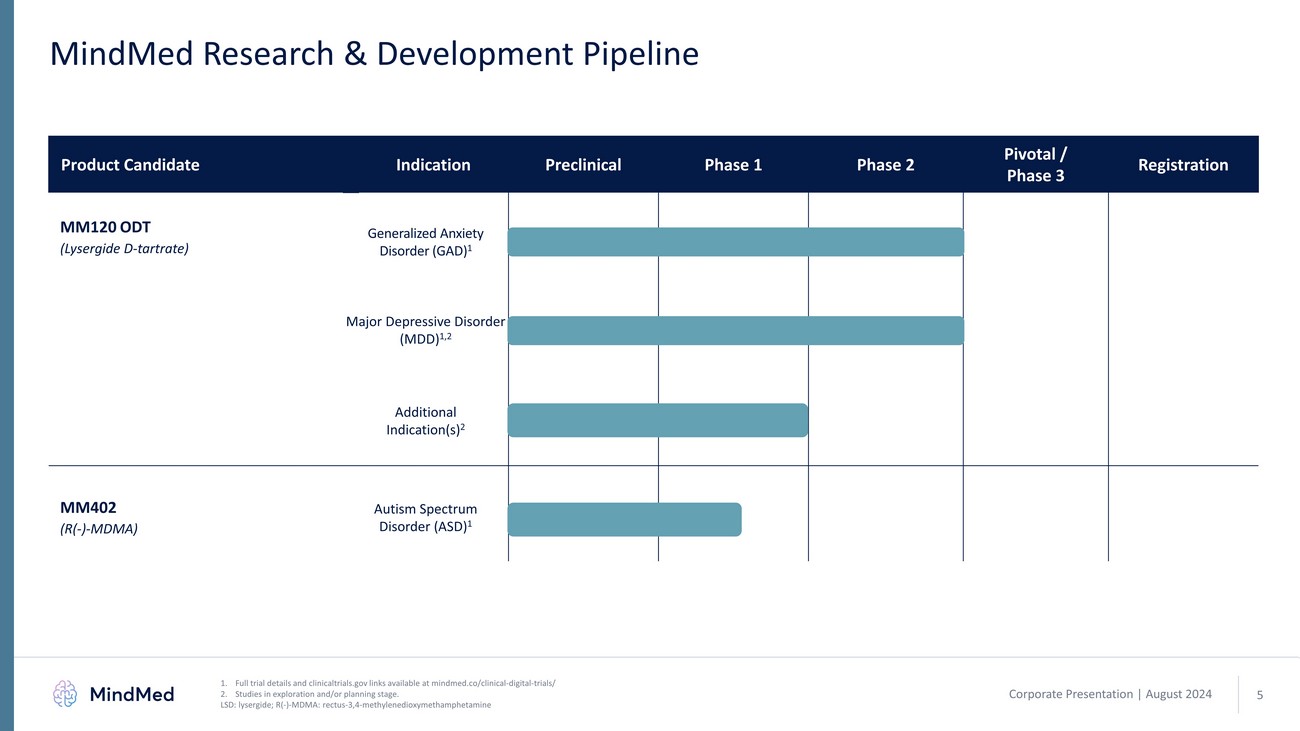
Corporate Presentation | August 2024 MindMed Research & Development Pipeline 1. Full trial details and clinicaltrials.gov links available at mindmed.co /clinical - digital - trials/ 2. Studies in exploration and/or planning stage. LSD: lysergide ; R( - ) - MDMA: rectus - 3,4 - methylenedioxymethamphetamine 5 Product Candidate Indication Preclinical Phase 1 Phase 2 Pivotal / Phase 3 Registration MM120 ODT ( Lysergide D - tartrate) Generalized Anxiety Disorder (GAD) 1 Major Depressive Disorder (MDD) 1,2 Additional Indication(s) 2 MM402 (R( - ) - MDMA) Autism Spectrum Disorder (ASD) 1 DK0
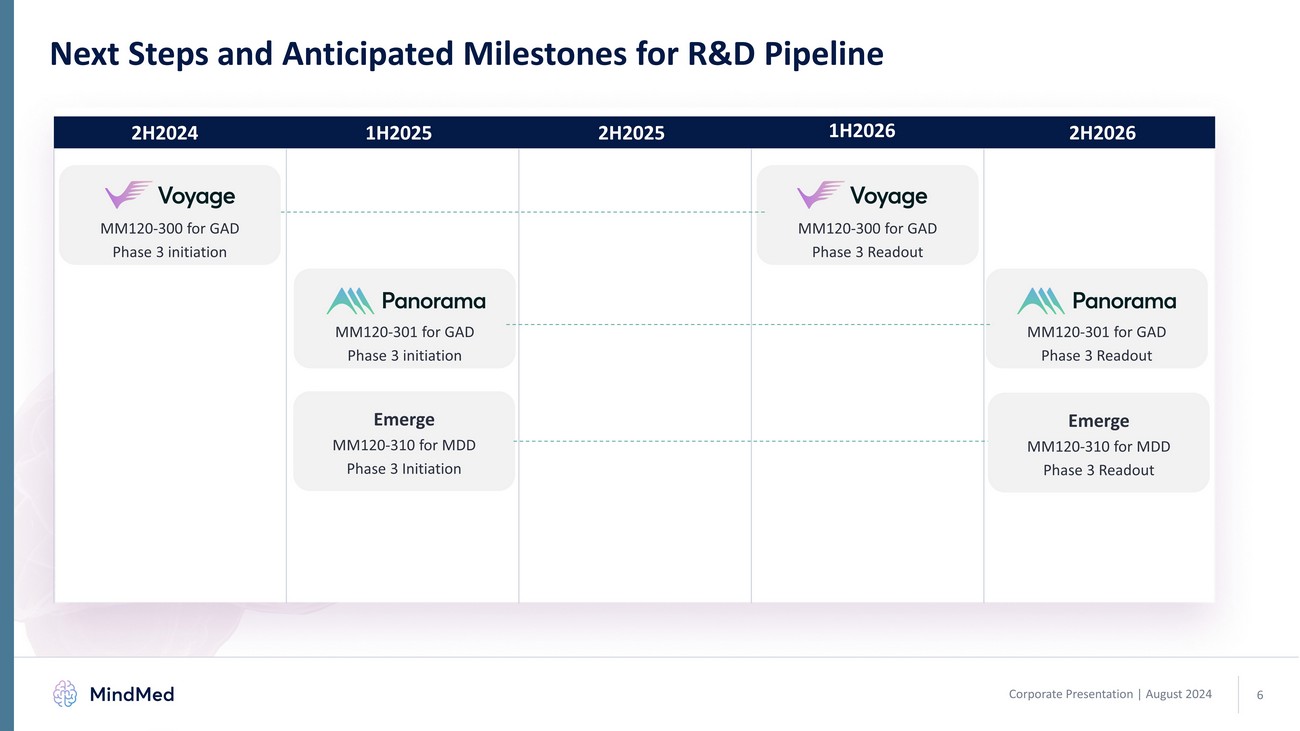
Corporate Presentation | August 2024 6 2H2024 1H2025 2H2025 1H2026 Next Steps and Anticipated Milestones for R&D Pipeline 2H2026 MM120 - 300 for GAD Phase 3 initiation MM120 - 301 for GAD Phase 3 initiation MM120 - 300 for GAD Phase 3 Readout MM120 - 301 for GAD Phase 3 Readout Emerge MM120 - 310 for MDD Phase 3 Initiation Emerge MM120 - 310 for MDD Phase 3 Readout DK0
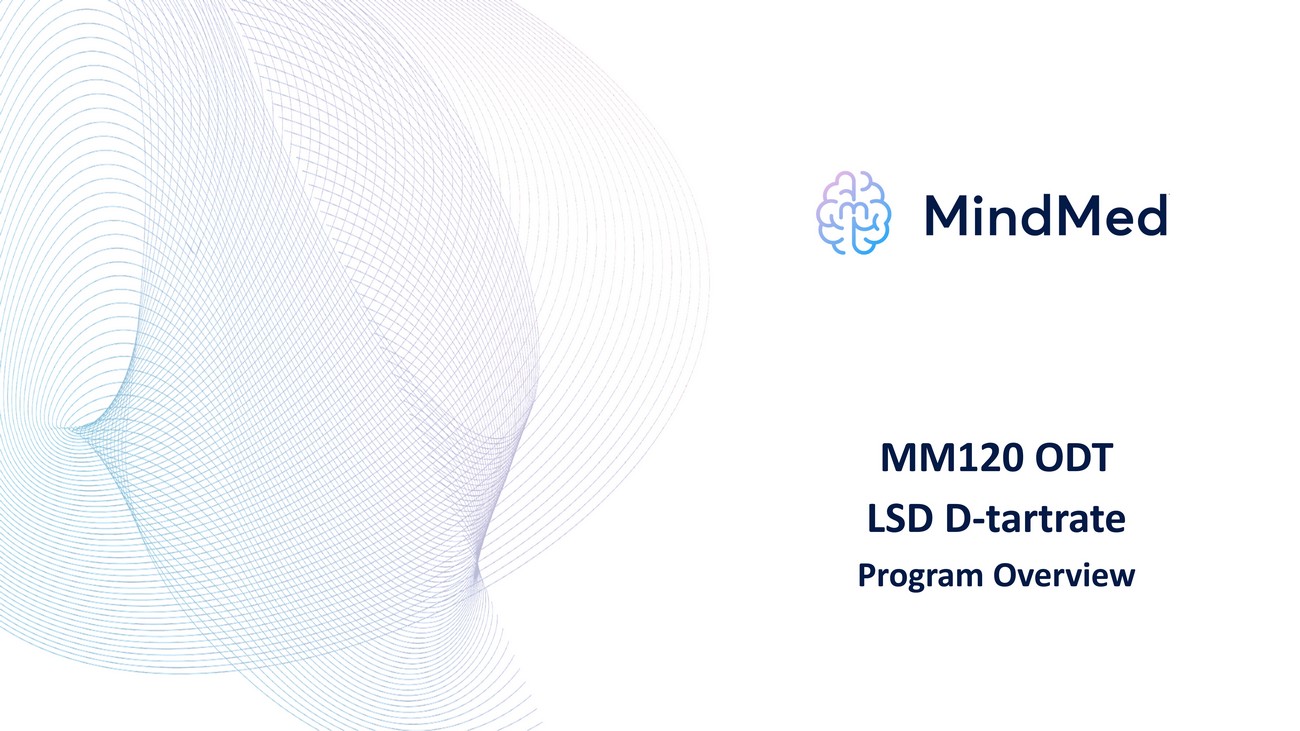
MM120 ODT LSD D - tartrate Program Overview
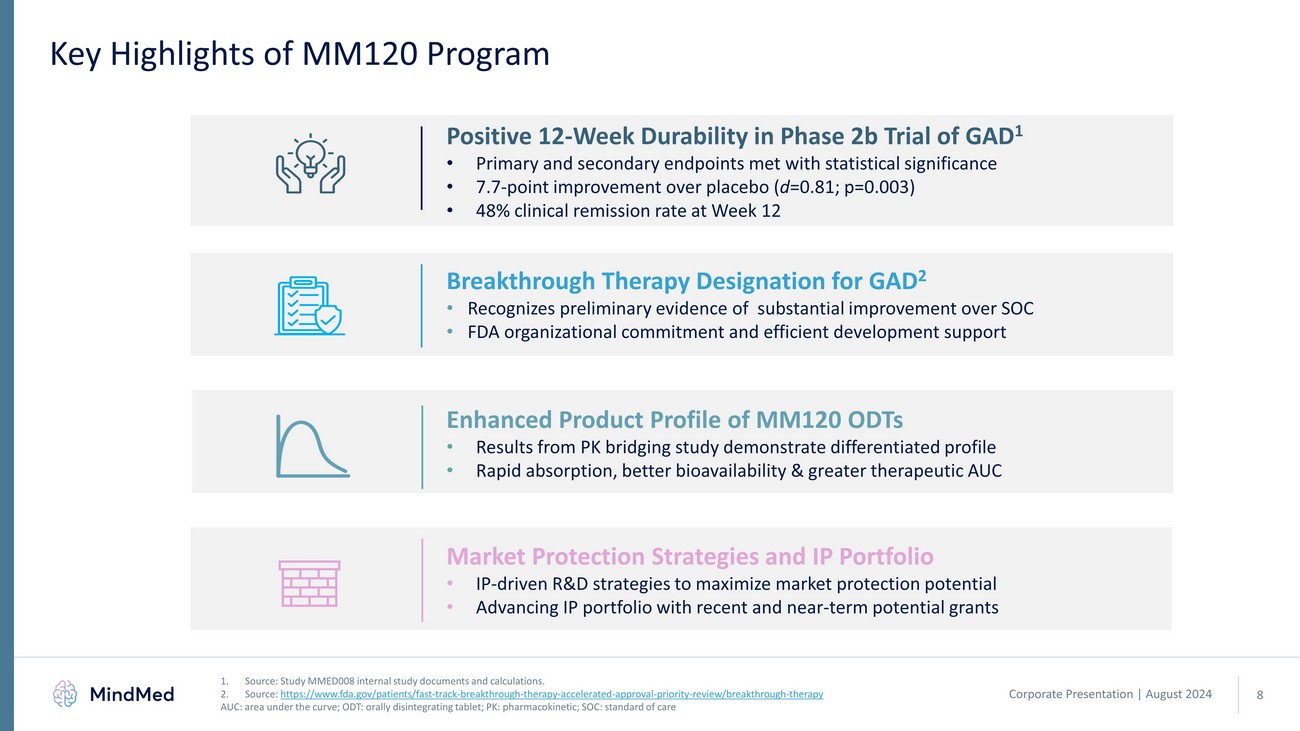
Corporate Presentation | August 2024 Key Highlights of MM120 Program 1. Source: Study MMED008 internal study documents and calculations. 2. Source: https://www.fda.gov/patients/fast - track - breakthrough - therapy - accelerated - approval - priority - review/breakthrough - therapy AUC: area under the curve; ODT: orally disintegrating tablet; PK: pharmacokinetic; SOC: standard of care Enhanced Product Profile of MM120 ODTs • Results from PK bridging study demonstrate differentiated profile • Rapid absorption, better bioavailability & greater therapeutic AUC Breakthrough Therapy Designation for GAD 2 • Recognizes preliminary evidence of substantial improvement over SOC • FDA organizational commitment and efficient development support Positive 12 - Week Durability in Phase 2b Trial of GAD 1 • Primary and secondary endpoints met with statistical significance • 7.7 - point improvement over placebo ( d =0.81; p=0.003) • 48 % clinical remission rate at Week 12 Market Protection Strategies and IP Portfolio • IP - driven R&D strategies to maximize market protection potential • Advancing IP portfolio with recent and near - term potential grants 8
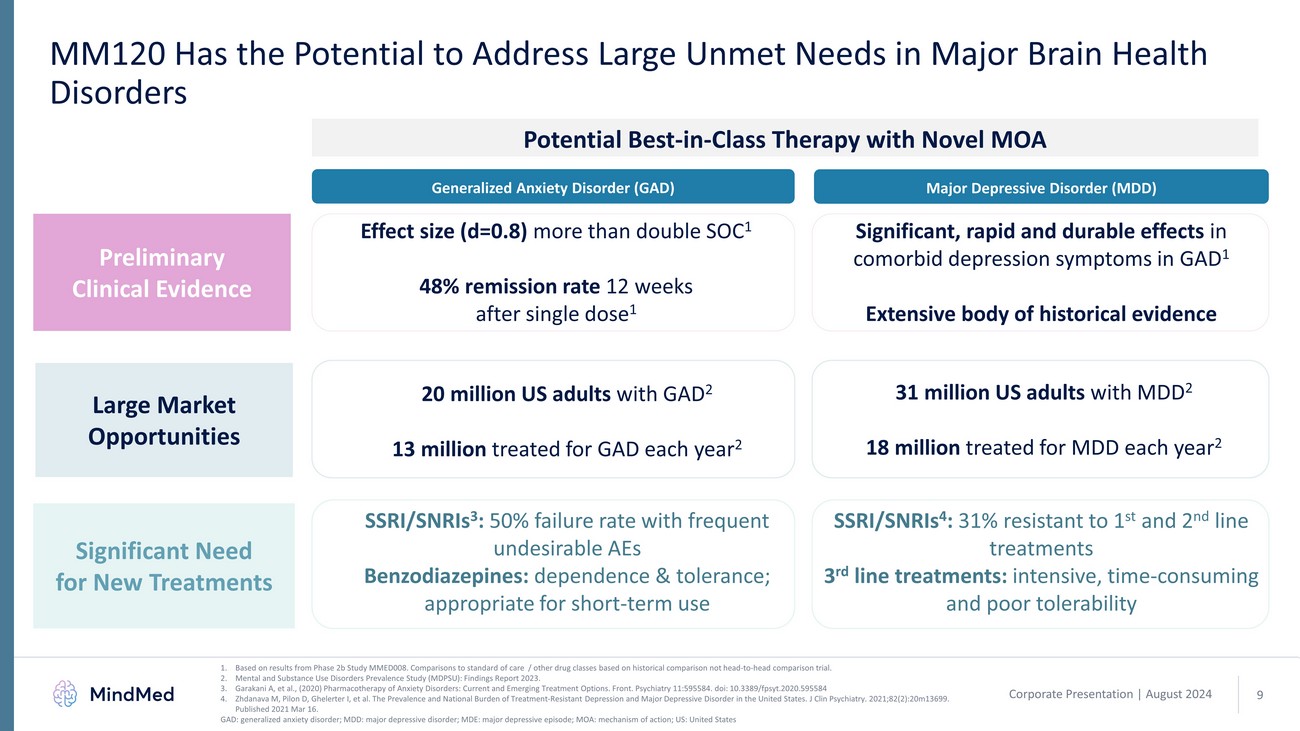
Corporate Presentation | August 2024 MM120 Has the Potential to Address Large Unmet Needs in Major Brain Health Disorders 1. Based on results from Phase 2b Study MMED008. Comparisons to standard of care / other drug classes based on historical compa ris on not head - to - head comparison trial. 2. Mental and Substance Use Disorders Prevalence Study (MDPSU): Findings Report 2023. 3. Garakani A, et al., (2020) Pharmacotherapy of Anxiety Disorders: Current and Emerging Treatment Options. Front. Psychiatry 11:595584. doi : 10.3389/fpsyt.2020.595584 4. Zhdanava M, Pilon D, Ghelerter I, et al. The Prevalence and National Burden of Treatment - Resistant Depression and Major Depressive Disorder in the United Stat es. J Clin Psychiatry. 2021;82(2):20m13699. Published 2021 Mar 16. GAD: generalized anxiety disorder; MDD: major depressive disorder; MDE: major depressive episode; MOA: mechanism of action; U S: United States Potential Best - in - Class Therapy with Novel MOA Large Market Opportunities Significant Need for New Treatments 20 million US adults with GAD 2 13 million treated for GAD each year 2 SSRI/SNRIs 3 : 50% failure rate with frequent undesirable AEs Benzodiazepines: dependence & tolerance; appropriate for short - term use 9 Preliminary Clinical Evidence Effect size (d=0.8) more than double SOC 1 48% remission rate 12 weeks after single dose 1 Generalized Anxiety Disorder (GAD) Major Depressive Disorder (MDD) Significant, rapid and durable effects in comorbid depression symptoms in GAD 1 Extensive body of historical evidence SSRI/SNRIs 4 : 31% resistant to 1 st and 2 nd line treatments 3 rd line treatments: intensive, time - consuming and poor tolerability 31 million US adults with MDD 2 18 million treated for MDD each year 2

Corporate Presentation | August 2024 10 Clinical Rationale and Mechanism of Action
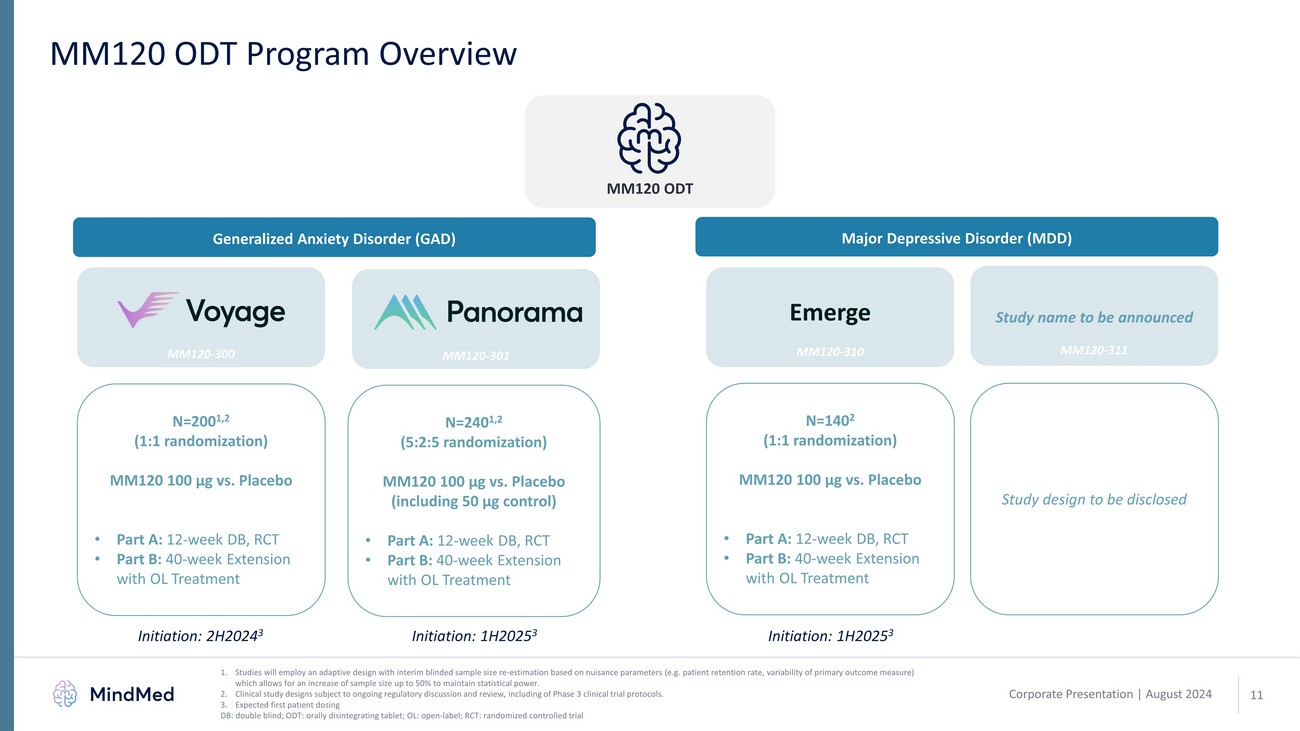
Corporate Presentation | August 2024 MM120 ODT Program Overview 1. Studies will employ an adaptive design with interim blinded sample size re - estimation based on nuisance parameters (e.g. patient retention rate, variability of primary outcome measure) which allows for an increase of sample size up to 50% to maintain statistical power. 2. Clinical study designs subject to ongoing regulatory discussion and review, including of Phase 3 clinical trial protocols. 3. Expected first patient dosing DB: double blind; ODT: orally disintegrating tablet; OL: open - label; RCT: randomized controlled trial 11 MM120 - 300 MM120 - 301 MM120 ODT Generalized Anxiety Disorder (GAD) Major Depressive Disorder (MDD) Emerge MM120 - 310 N=200 1,2 (1 :1 randomization) MM120 100 µg vs. Placebo • Part A: 12 - week DB, RCT • Part B: 40 - week Extension with OL Treatment N=240 1,2 (5:2:5 randomization) MM120 100 µg vs. Placebo (including 50 µg control) • Part A: 12 - week DB, RCT • Part B: 40 - week Extension with OL Treatment N=140 2 (1:1 randomization) MM120 100 µg vs. Placebo • Part A: 12 - week DB, RCT • Part B: 40 - week Extension with OL Treatment Initiation: 2H2024 3 Initiation: 1H2025 3 Initiation: 1H2025 3 Study name to be announced MM120 - 311 Study design to be disclosedDK0
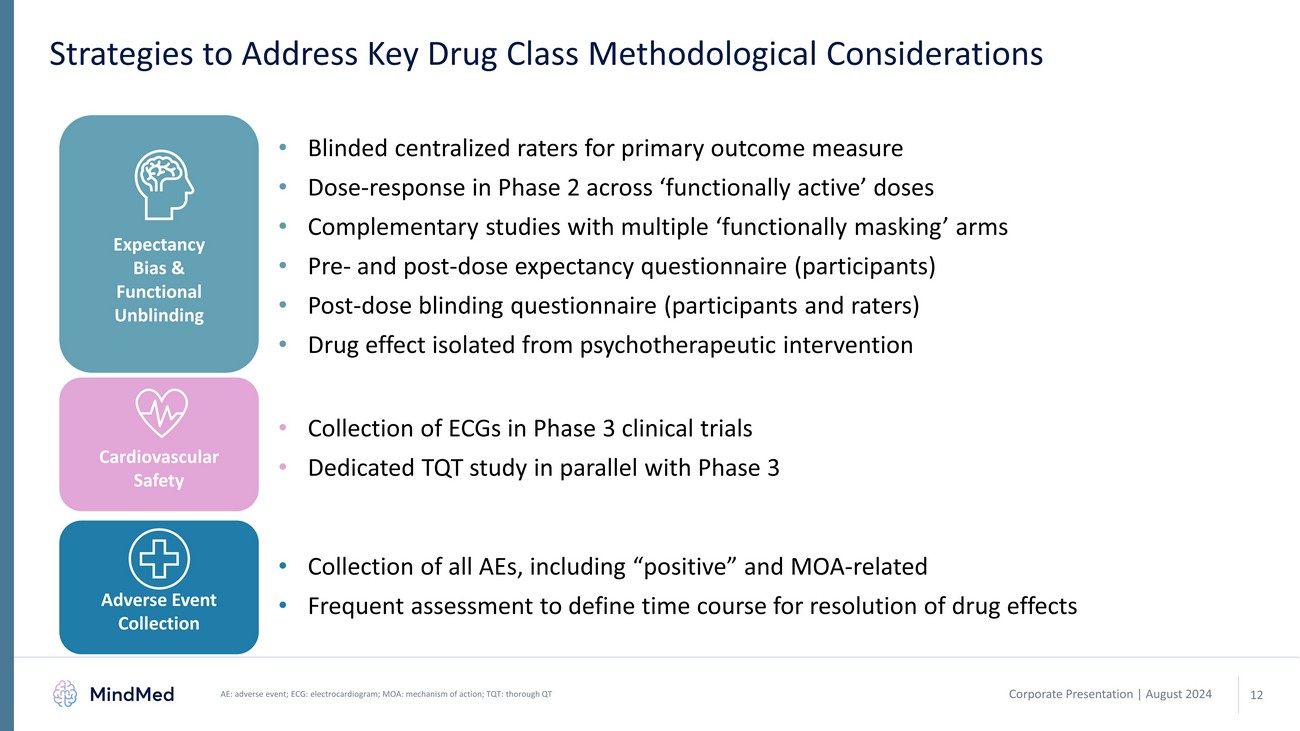
Corporate Presentation | August 2024 Strategies to Address Key Drug Class Methodological Considerations AE: adverse event; ECG: electrocardiogram; MOA: mechanism of action; TQT: thorough QT 12 Expectancy Bias & Functional Unblinding Cardiovascular Safety Adverse Event Collection • Blinded centralized raters for primary outcome measure • Dose - response in Phase 2 across ‘functionally active’ doses • Complementary studies with multiple ‘functionally masking’ arms • Pre - and post - dose expectancy questionnaire (participants) • Post - dose blinding questionnaire (participants and raters) • Drug effect isolated from psychotherapeutic intervention • Collection of ECGs in Phase 3 clinical trials • Dedicated TQT study in parallel with Phase 3 • Collection of all AEs, including “positive” and MOA - related • Frequent assessment to define time course for resolution of drug effects

Corporate Presentation | August 2024 +1y +2y +3y +4y +9y +5y +7y … 2043+ New Chemical Entity Exclusivity 30 - Month Stay 1. Section 505 of the Federal Food, Drug and Cosmetic Act, 21 U.S.C. § 355. PK: pharmacokinetic; PD: pharmacodynamic MM120 Launch Potential Patent Protection Method of Use / Method of Treatment: Treatment of a Disorder Delivery: Delivery Method, PK / PD Drug Product: Method of Manufacture/Process API: Polymorph, Salt Form • Supply chain availability • Exclusive rights to key technology • Lifecycle management with improved product performance • Trade secrets & know - how • Differentiated product performance • Differentiated combination (drug and/or device products) Additional Potential Protections Regulatory Protection 1 MM120 | Multiple Layers of Intellectual Property and Protection 13
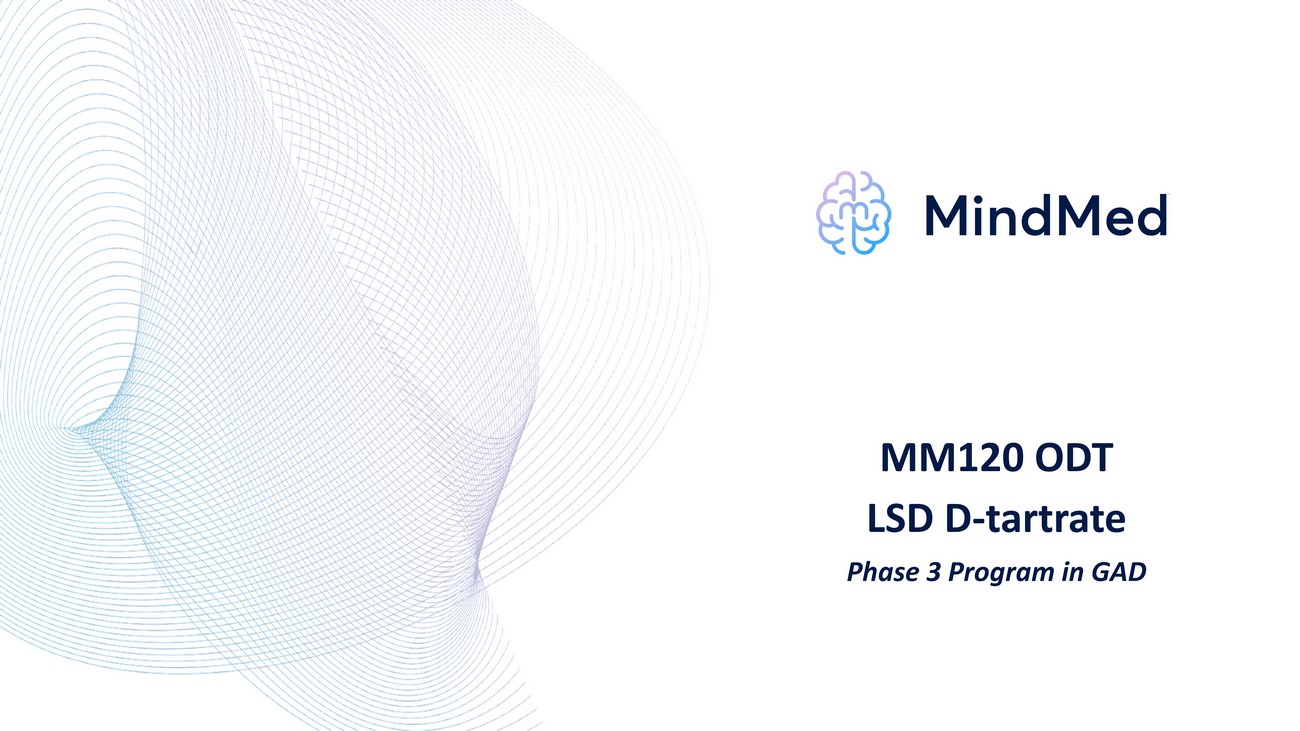
MM120 ODT LSD D - tartrate Phase 3 Program in GAD
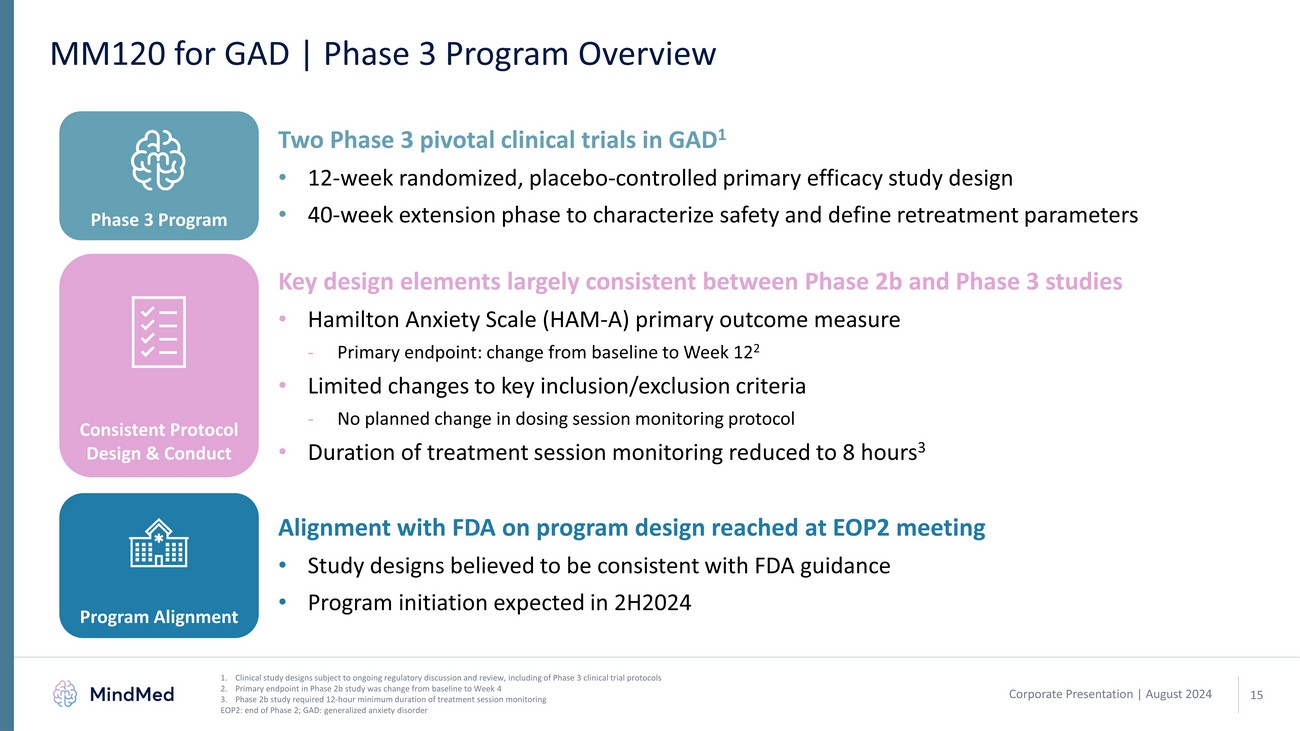
Corporate Presentation | August 2024 MM120 for GAD | Phase 3 Program Overview 15 1. Clinical study designs subject to ongoing regulatory discussion and review, including of Phase 3 clinical trial protocols 2. Primary endpoint in Phase 2b study was change from baseline to Week 4 3. Phase 2b study required 12 - hour minimum duration of treatment session monitoring EOP2: end of Phase 2; GAD: generalized anxiety disorder Phase 3 Program Consistent Protocol Design & Conduct Program Alignment Two Phase 3 pivotal clinical trials in GAD 1 • 12 - week randomized, placebo - controlled primary efficacy study design • 40 - week extension phase to characterize safety and define retreatment parameters Key design elements largely consistent between Phase 2b and Phase 3 studies • Hamilton Anxiety Scale (HAM - A) primary outcome measure - Primary endpoint: change from baseline to Week 12 2 • Limited changes to key inclusion/exclusion criteria - No planned change in dosing session monitoring protocol • Duration of treatment session monitoring reduced to 8 hours 3 Alignment with FDA on program design reached at EOP2 meeting • Study designs believed to be consistent with FDA guidance • Program initiation expected in 2H2024 DK0
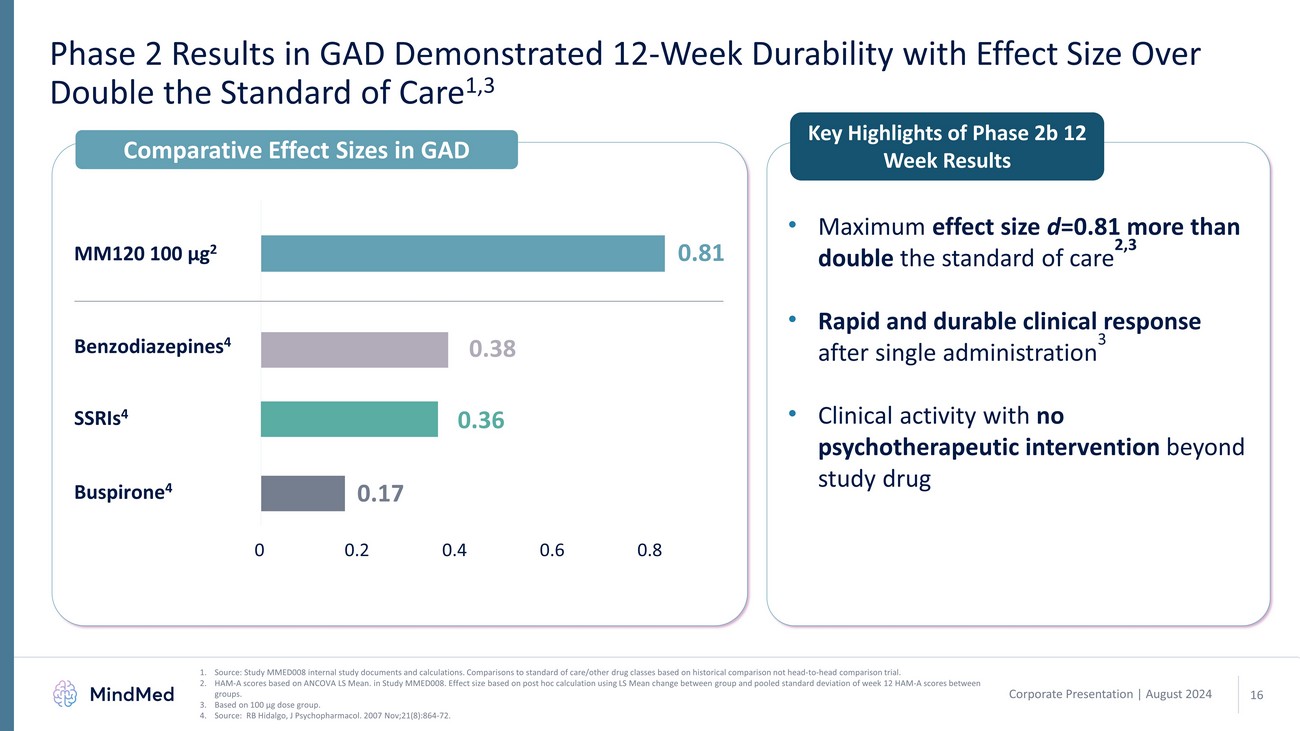
Corporate Presentation | August 2024 Phase 2 Results in GAD Demonstrated 12 - Week Durability with Effect Size Over Double the Standard of Care 1,3 1. Source: Study MMED008 internal study documents and calculations. Comparisons to standard of care/other drug classes based on his torical comparison not head - to - head comparison trial. 2. HAM - A scores based on ANCOVA LS Mean. in Study MMED008. Effect size based on post hoc calculation using LS Mean change between g roup and pooled standard deviation of week 12 HAM - A scores between groups. 3. Based on 100 µg dose group. 4. Source: RB Hidalgo, J Psychopharmacol . 2007 Nov;21(8):864 - 72. • Maximum effect size d =0.81 more than double the standard of care 2,3 • Rapid and durable clinical response after single administration 3 • Clinical activity with no psychotherapeutic intervention beyond study drug ^^Z/Ɛ ϰ ĞŶnjŽĚŝĂnj Ğ ƉŝŶĞ s 4 0 0.2 0.4 0.6 0.8 0.38 0.36 ƵƐƉŝƌŽŶĞ ϰ 0.17 0.81 MM120 100 µg 2 Comparative Effect Sizes in GAD Key Highlights of Phase 2b 12 Week Results 16
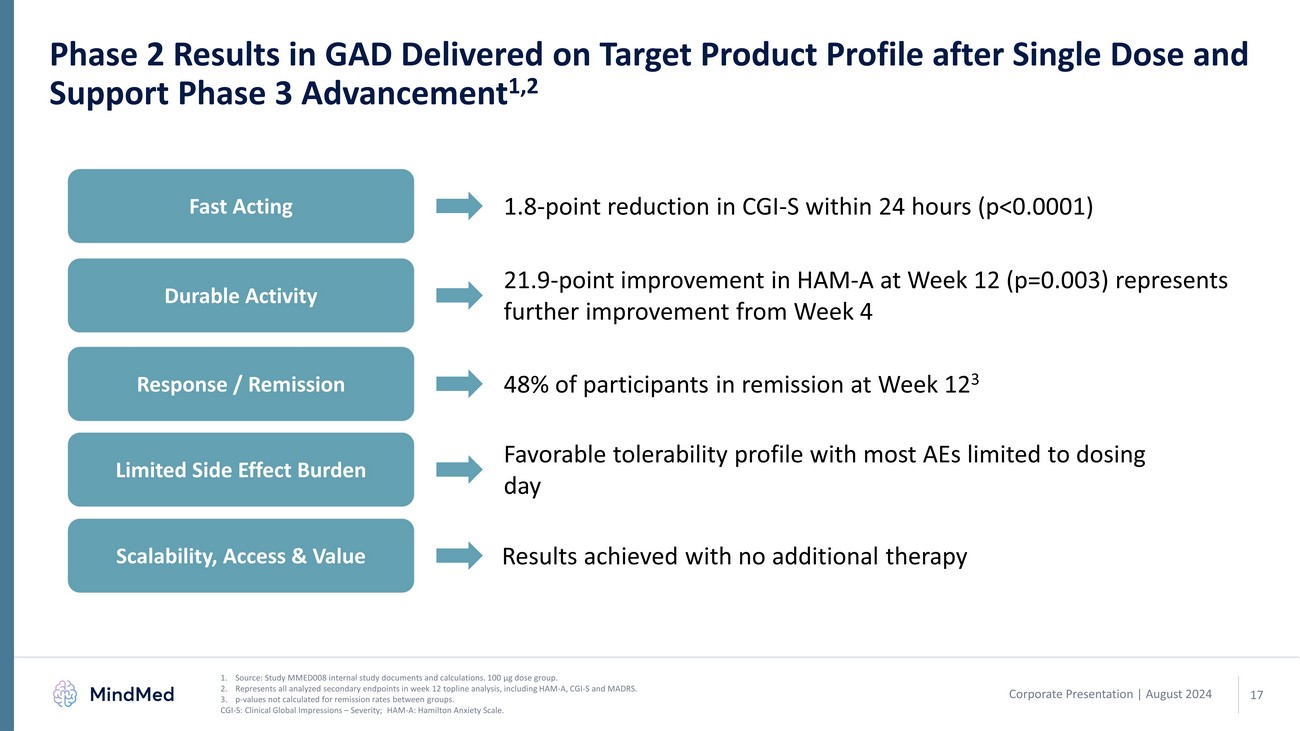
Corporate Presentation | August 2024 17 Phase 2 Results in GAD Delivered on Target Product Profile after Single Dose and Support Phase 3 Advancement 1,2 1. Source: Study MMED008 internal study documents and calculations. 100 µg dose group. 2. Represents all analyzed secondary endpoints in week 12 topline analysis, including HAM - A, CGI - S and MADRS. 3. p - values not calculated for remission rates between groups. CGI - S: Clinical Global Impressions – Severity; HAM - A: Hamilton Anxiety Scale. Fast Acting Response / Remission Durable Activity Scalability, Access & Value 1.8 - point reduction in CGI - S within 24 hours (p<0.0001) 21.9 - point improvement in HAM - A at Week 12 (p=0.003) represents further improvement from Week 4 48% of participants in remission at Week 12 3 Limited Side Effect Burden Favorable tolerability profile with most AEs limited to dosing day Results achieved with no additional therapyDK0
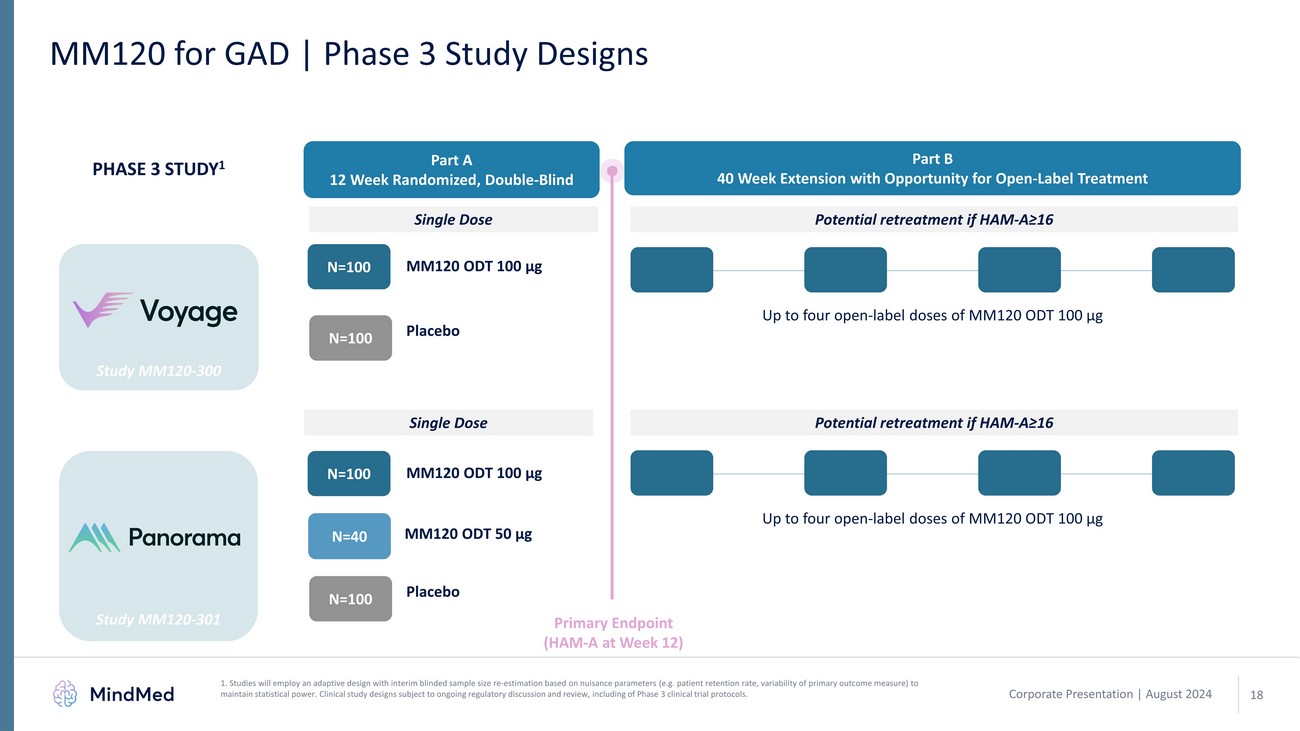
Corporate Presentation | August 2024 Study MM120 - 301 Study MM120 - 300 MM120 for GAD | Phase 3 Study Designs 1. Studies will employ an adaptive design with interim blinded sample size re - estimation based on nuisance parameters (e.g. pati ent retention rate, variability of primary outcome measure) to maintain statistical power. Clinical study designs subject to ongoing regulatory discussion and review, including of Phase 3 cli nical trial protocols. 18 MM120 ODT 1 00 µg N=100 Placebo N=100 Part A 12 Week Randomized, Double - Blind Part B 40 Week Extension with Opportunity for Open - Label Treatment MM120 ODT 1 00 µg N=100 Placebo N=100 MM120 ODT 50 µg N=40 PHASE 3 STUDY 1 Single Dose Potential retreatment if HAM - A≥16 Primary Endpoint (HAM - A at Week 12) Up to four open - label doses of MM120 ODT 1 00 µg Single Dose Potential retreatment if HAM - A≥16 Up to four open - label doses of MM120 ODT 1 00 µg DK0
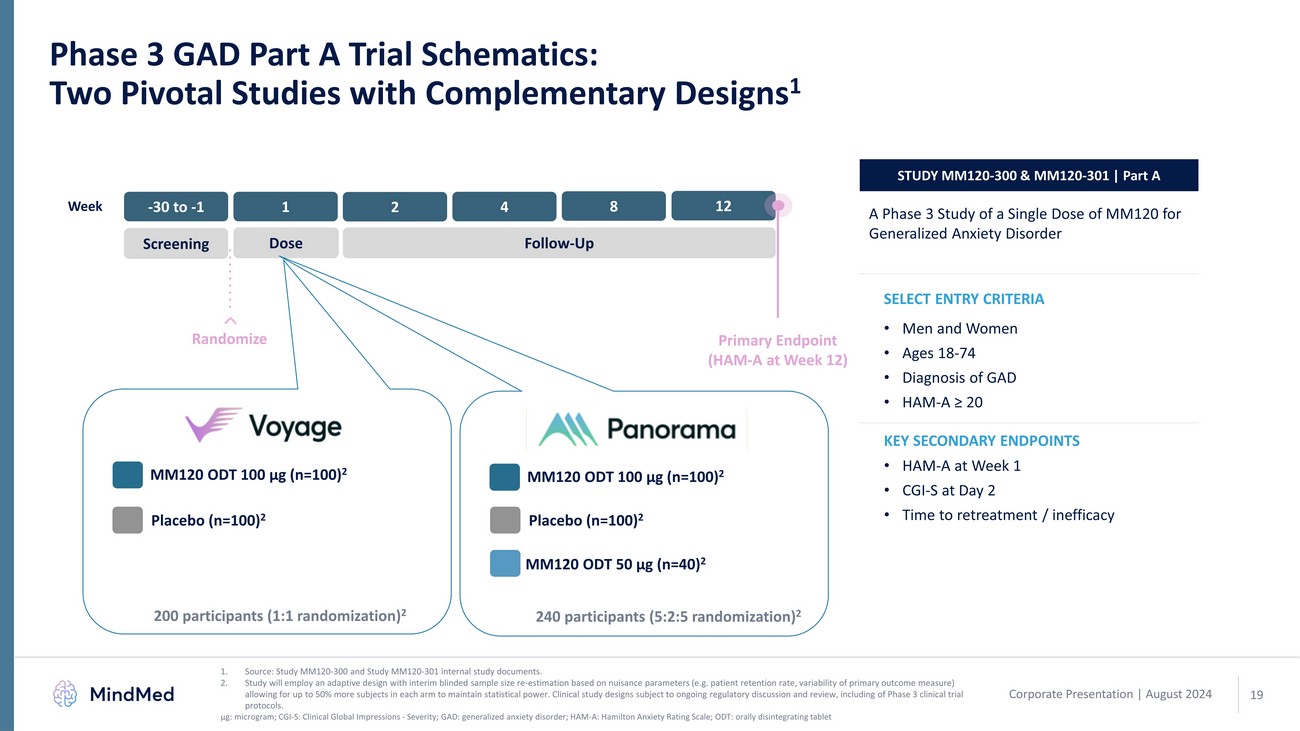
Corporate Presentation | August 2024 19 Phase 3 GAD Part A Trial Schematics: Two Pivotal Studies with Complementary Designs 1 1. Source: Study MM120 - 300 and Study MM120 - 301 internal study documents. 2. Study will employ an adaptive design with interim blinded sample size re - estimation based on nuisance parameters (e.g. patient r etention rate, variability of primary outcome measure) allowing for up to 50% more subjects in each arm to maintain statistical power. Clinical study designs subject to ongoing reg ula tory discussion and review, including of Phase 3 clinical trial protocols. μ g: microgram; CGI - S: Clinical Global Impressions - Severity; GAD: generalized anxiety disorder; HAM - A: Hamilton Anxiety Rating S cale; ODT: orally disintegrating tablet STUDY MM120 - 300 & MM120 - 301 | Part A • HAM - A at Week 1 • CGI - S at Day 2 • Time to retreatment / inefficacy SELECT ENTRY CRITERIA • Men and Women • Ages 18 - 74 • Diagnosis of GAD • HAM - A ≥ 20 A Phase 3 Study of a Single Dose of MM120 for Generalized Anxiety Disorder KEY SECONDARY ENDPOINTS 240 participants (5:2:5 randomization) 2 Week Randomize - 30 to - 1 1 2 4 8 12 MM120 ODT 1 00 µg (n=100) 2 MM120 ODT 50 µg (n=40) 2 Placebo (n=100) 2 Screening Dose Follow - Up Primary Endpoint (HAM - A at Week 12) 200 participants (1:1 randomization) 2 MM120 ODT 1 00 µg (n=100) 2 Placebo (n=100) 2
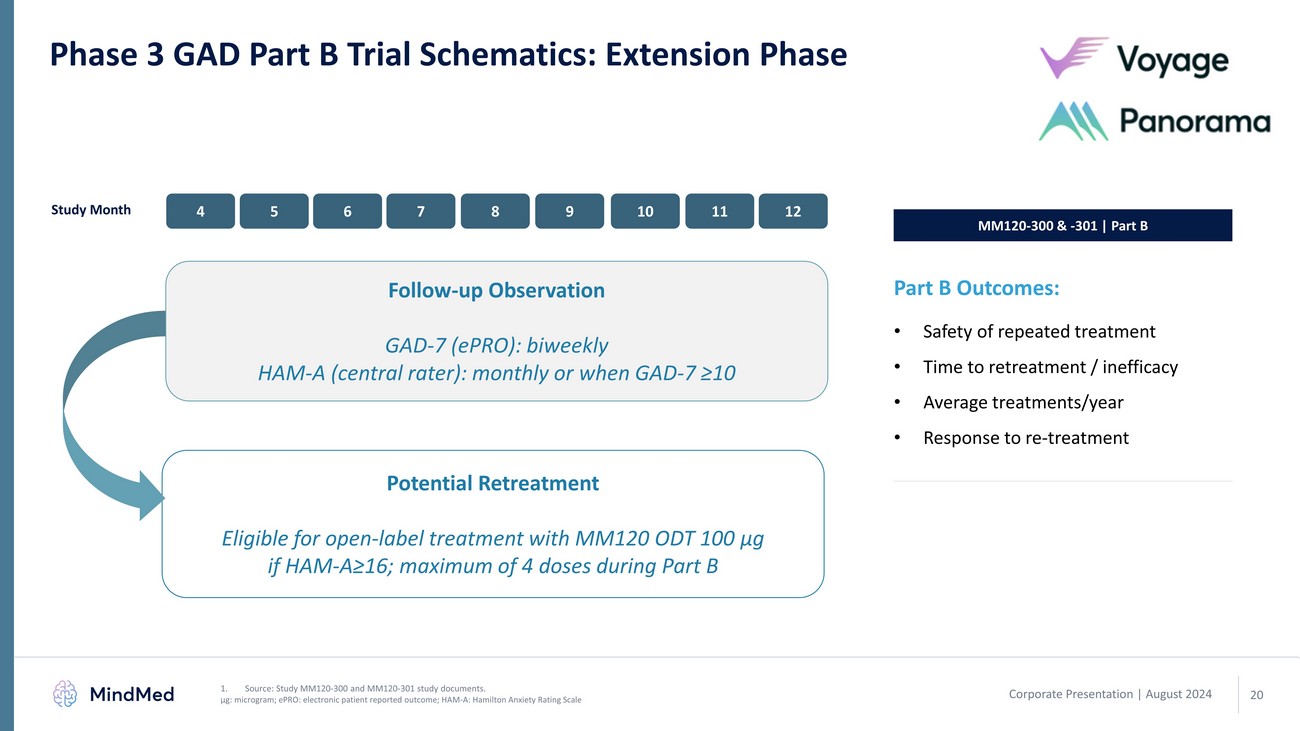
Corporate Presentation | August 2024 20 Phase 3 GAD Part B Trial Schematics: Extension Phase 1. Source: Study MM120 - 300 and MM120 - 301 study documents. μ g: microgram; ePRO: electronic patient reported outcome; HAM - A: Hamilton Anxiety Rating Scale 4 5 6 7 8 9 10 11 12 Study Month Follow - up Observation GAD - 7 (ePRO): biweekly HAM - A (central rater): monthly or when GAD - 7 ≥10 Potential Retreatment Eligible for open - label treatment with MM120 ODT 100 µg if HAM - A≥16; maximum of 4 doses during Part B MM120 - 300 & - 301 | Part B Part B Outcomes: • Safety of repeated treatment • Time to retreatment / inefficacy • Average treatments/year • Response to re - treatment
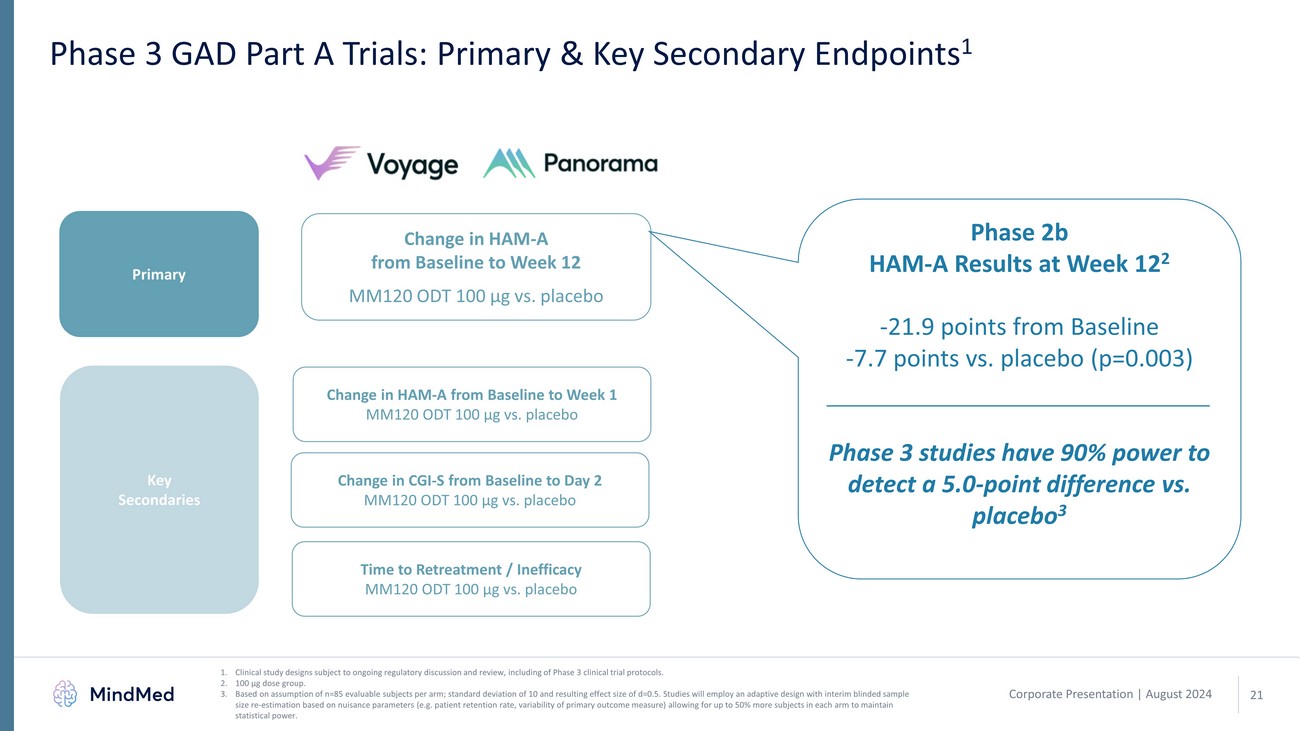
Corporate Presentation | August 2024 Phase 3 GAD Part A Trials: Primary & Key Secondary Endpoints 1 1. Clinical study designs subject to ongoing regulatory discussion and review, including of Phase 3 clinical trial protocols. 2. 100 µg dose group. 3. Based on assumption of n=85 evaluable subjects per arm; standard deviation of 10 and resulting effect size of d=0.5. Studies wil l employ an adaptive design with interim blinded sample size re - estimation based on nuisance parameters (e.g. patient retention rate, variability of primary outcome measure) allowing f or up to 50% more subjects in each arm to maintain statistical power. 21 Primary Key Secondaries Change in HAM - A from Baseline to Week 12 MM120 ODT 100 µg vs. placebo Change in HAM - A from Baseline to Week 1 MM120 ODT 100 µg vs. placebo Change in CGI - S from Baseline to Day 2 MM120 ODT 100 µg vs. placebo Time to Retreatment / Inefficacy MM120 ODT 100 µg vs. placebo Phase 2b HAM - A Results at Week 12 2 - 21.9 points from Baseline - 7.7 points vs. placebo (p=0.003) Phase 3 studies have 90% power to detect a 5.0 - point difference vs. placebo 3DK0
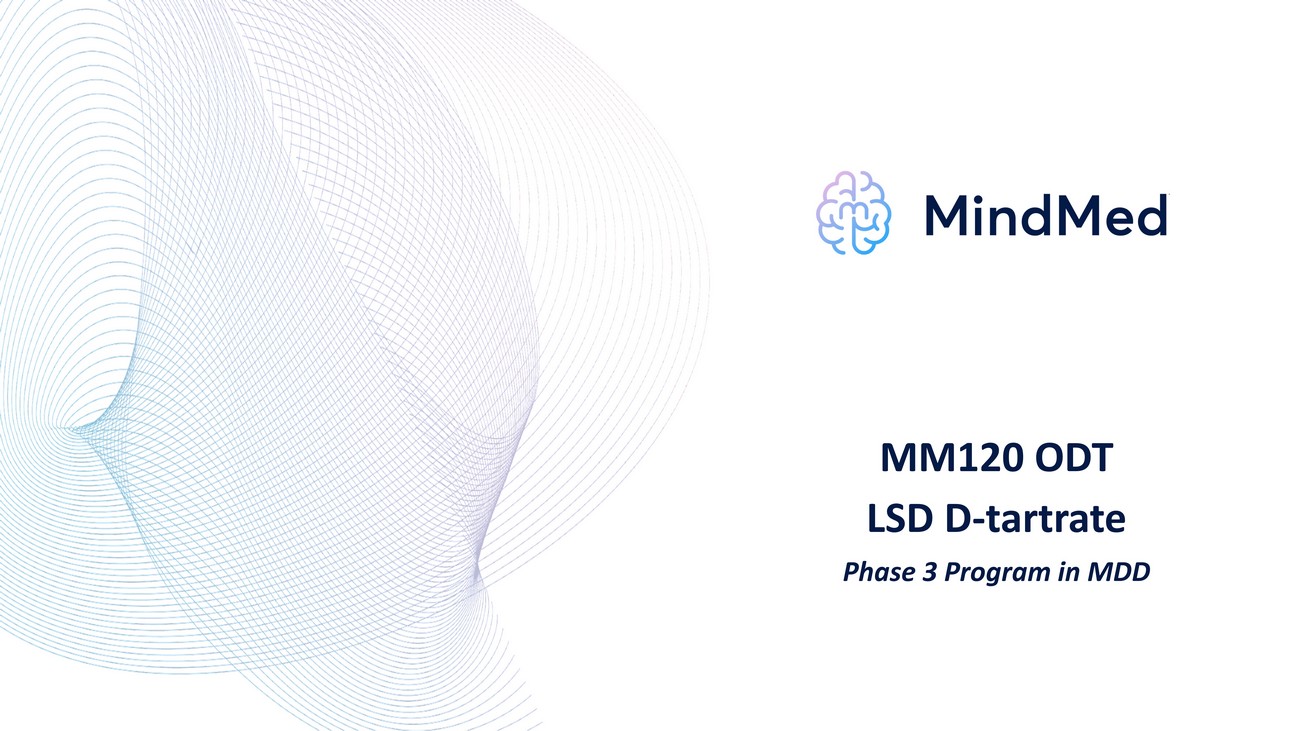
MM120 ODT LSD D - tartrate Phase 3 Program in MDD
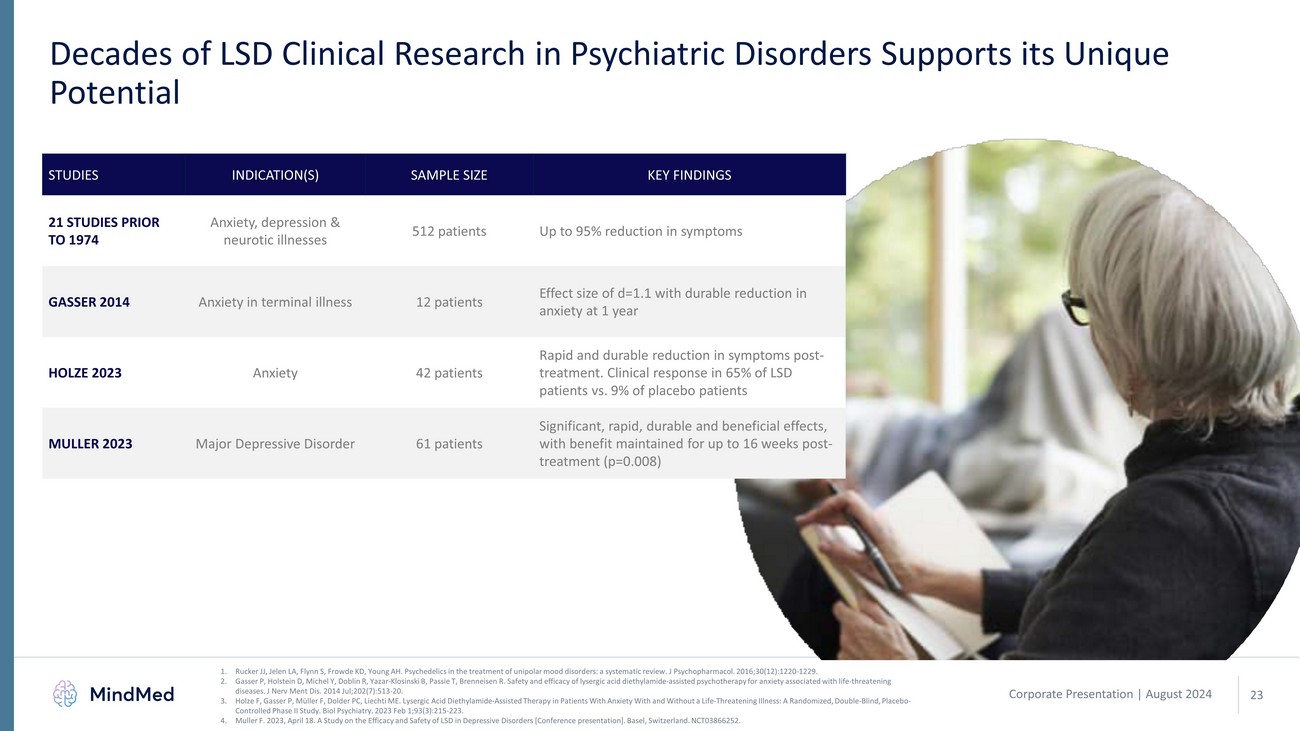
Corporate Presentation | August 2024 Decades of LSD Clinical Research in Psychiatric Disorders Supports its Unique Potential 1. Rucker JJ, Jelen LA, Flynn S, Frowde KD, Young AH. Psychedelics in the treatment of unipolar mood disorders: a systematic review. J Psychopharmacol . 2016;30(12):1220 - 1229. 2. Gasser P, Holstein D, Michel Y, Doblin R, Yazar - Klosinski B, Passie T, Brenneisen R. Safety and efficacy of lysergic acid diethylamide - assisted psychotherapy for anxiety associated with life - threatening diseases. J Nerv Ment Dis. 2014 Jul;202(7):513 - 20. 3. Holze F, Gasser P, Müller F, Dolder PC, Liechti ME. Lysergic Acid Diethylamide - Assisted Therapy in Patients With Anxiety With and Without a Life - Threatening Illness: A Randomi zed, Double - Blind, Placebo - Controlled Phase II Study. Biol Psychiatry. 2023 Feb 1;93(3):215 - 223. 4. Muller F. 2023, April 18. A Study on the Efficacy and Safety of LSD in Depressive Disorders [Conference presentation]. Basel, Sw itzerland. NCT03866252. 23 STUDIES INDICATION(S) SAMPLE SIZE KEY FINDINGS 21 STUDIES PRIOR TO 1974 Anxiety, depression & neurotic illnesses 512 patients Up to 95% reduction in symptoms GASSER 2014 Anxiety in terminal illness 12 patients Effect size of d=1.1 with durable reduction in anxiety at 1 year HOLZE 2023 Anxiety 42 patients Rapid and durable reduction in symptoms post - treatment. Clinical response in 65% of LSD patients vs. 9% of placebo patients MULLER 2023 Major Depressive Disorder 61 patients Significant, rapid, durable and beneficial effects, with benefit maintained for up to 16 weeks post - treatment (p=0.008)
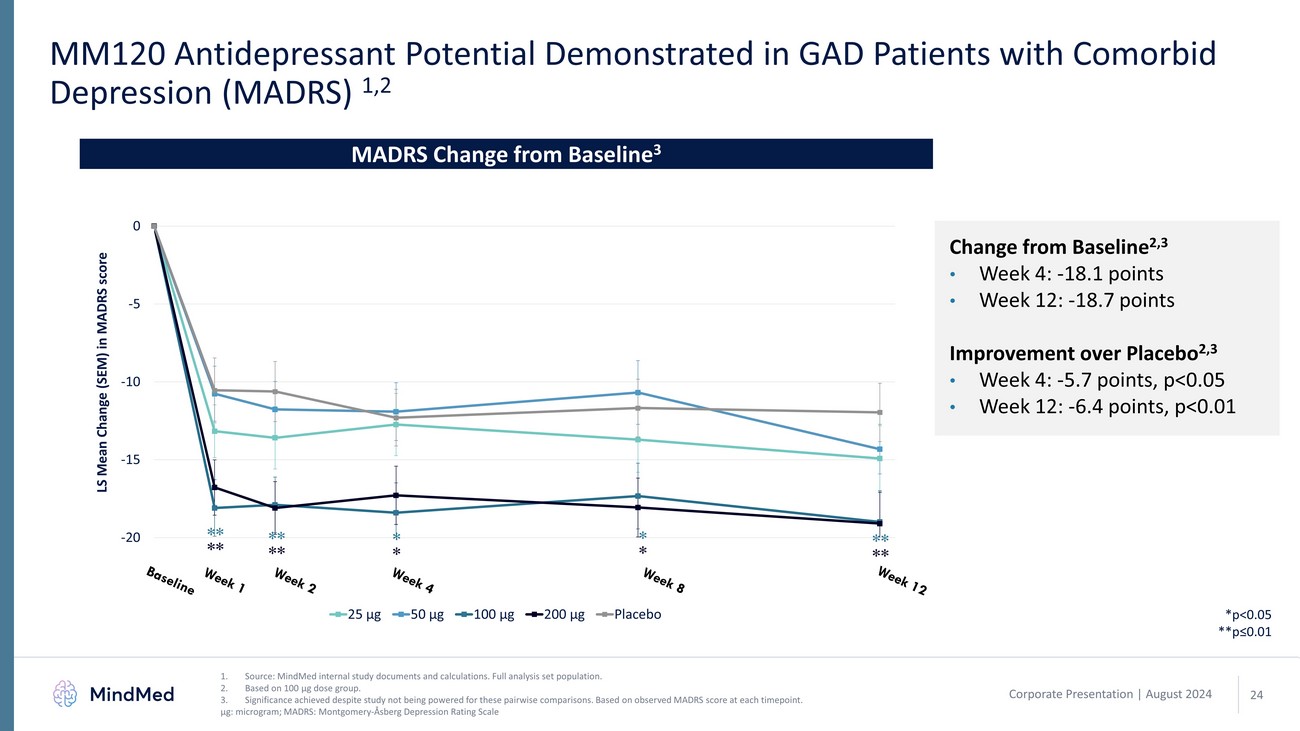
Corporate Presentation | August 2024 24 MM120 Antidepressant Potential Demonstrated in GAD Patients with Comorbid Depression (MADRS) 1,2 1. Source: MindMed internal study documents and calculations. Full analysis set population. 2. Based on 100 µg dose group. 3. Significance achieved despite study not being powered for these pairwise comparisons. Based on observed MADRS score at each t ime point. μ g: microgram; MADRS: Montgomery - Åsberg Depression Rating Scale MADRS Change from Baseline 3 Change from Baseline 2,3 • Week 4: - 18.1 points • Week 12: - 18.7 points Improvement over Placebo 2,3 • Week 4: - 5.7 points, p<0.05 • Week 12: - 6.4 points, p<0.01 *p<0.05 **p≤0.01 -20 -15 -10 -5 0 LS Mean Change (SEM) in MADRS score 25 µg 50 µg 100 µg 200 µg Placebo ** ** ** ** * * ** ** * *
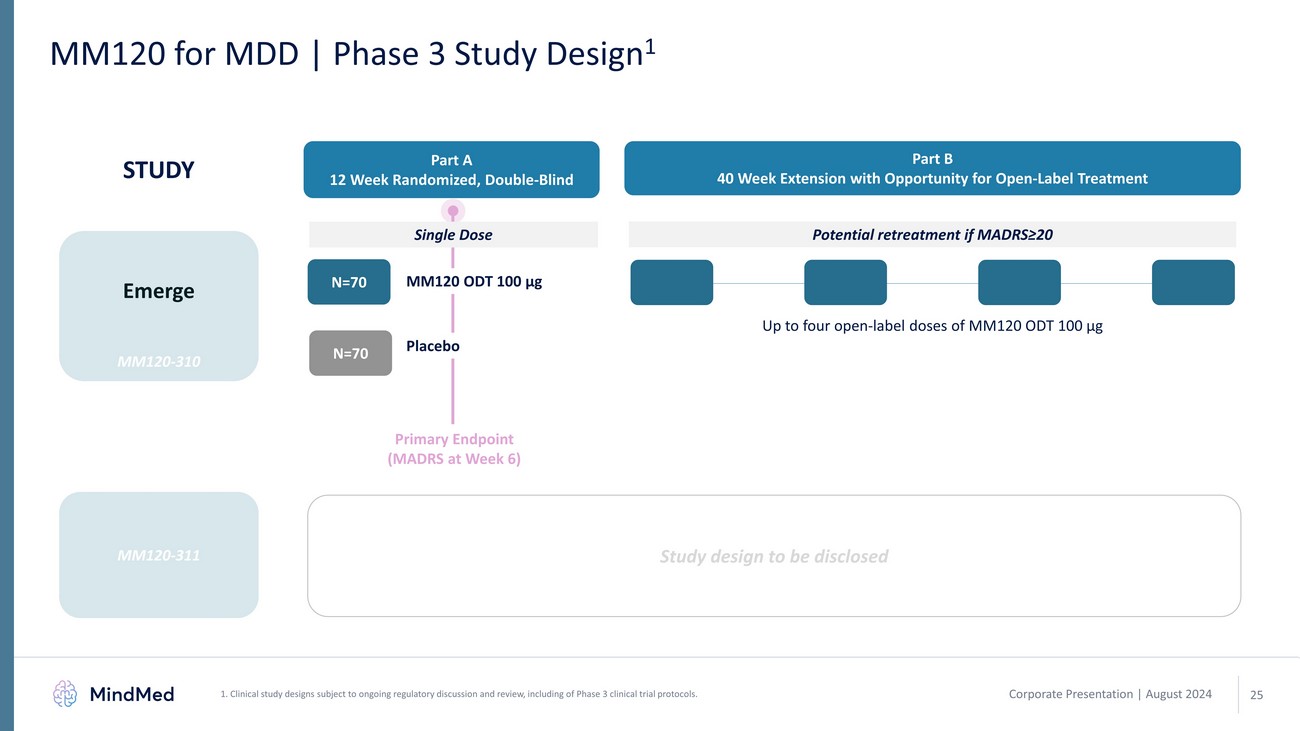
Corporate Presentation | August 2024 Emerge MM120 - 310 MM120 for MDD | Phase 3 Study Design 1 1. Clinical study designs subject to ongoing regulatory discussion and review, including of Phase 3 clinical trial protocols. 25 N=70 N=70 Part A 12 Week Randomized, Double - Blind Part B 40 Week Extension with Opportunity for Open - Label Treatment STUDY Primary Endpoint (MADRS at Week 6) Potential retreatment if MADRS≥20 Up to four open - label doses of MM120 ODT 1 00 µg MM120 ODT 1 00 µg Placebo Single Dose MM120 - 311 Study design to be disclosed
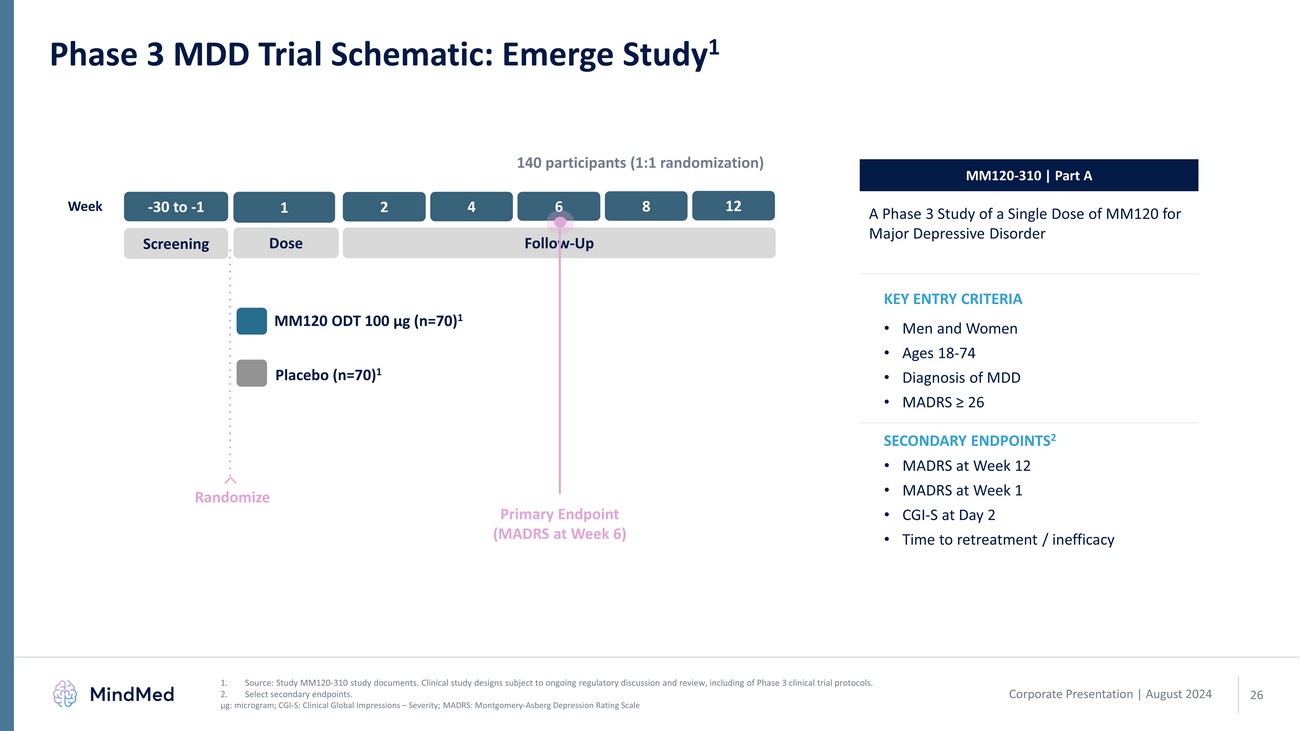
Corporate Presentation | August 2024 26 Phase 3 MDD Trial Schematic: Emerge Study 1 1. Source: Study MM120 - 310 study documents. Clinical study designs subject to ongoing regulatory discussion and review, including o f Phase 3 clinical trial protocols. 2. Select secondary endpoints. μ g: microgram; CGI - S: Clinical Global Impressions – Severity; MADRS: Montgomery - Asberg Depression Rating Scale MM120 - 310 | Part A • MADRS at Week 12 • MADRS at Week 1 • CGI - S at Day 2 • Time to retreatment / inefficacy KEY ENTRY CRITERIA • Men and Women • Ages 18 - 74 • Diagnosis of MDD • MADRS ≥ 26 A Phase 3 Study of a Single Dose of MM120 for Major Depressive Disorder SECONDARY ENDPOINTS 2 140 participants (1:1 randomization) Week Randomize - 30 to - 1 1 2 4 8 12 MM120 ODT 1 00 µg (n=70) 1 Placebo (n=70) 1 Screening Dose Follow - Up 6 Primary Endpoint (MADRS at Week 6)
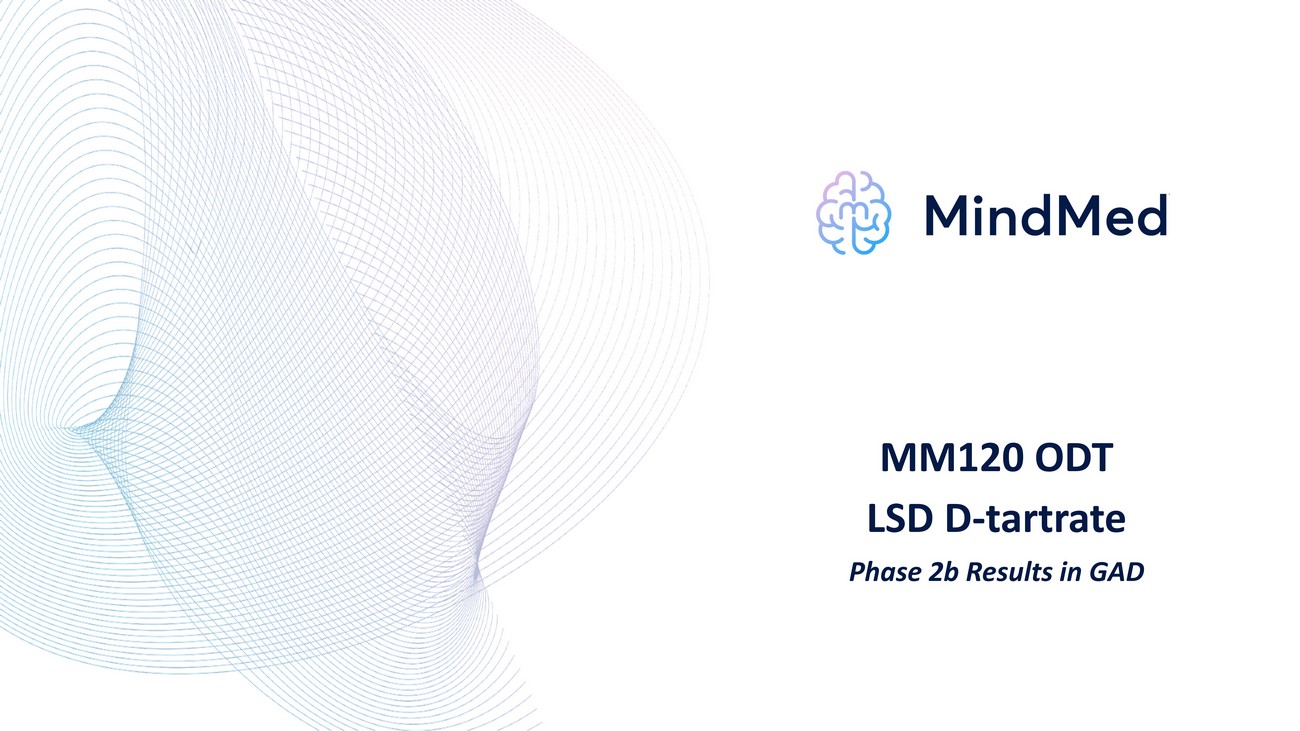
MM120 ODT LSD D - tartrate Phase 2b Results in GAD
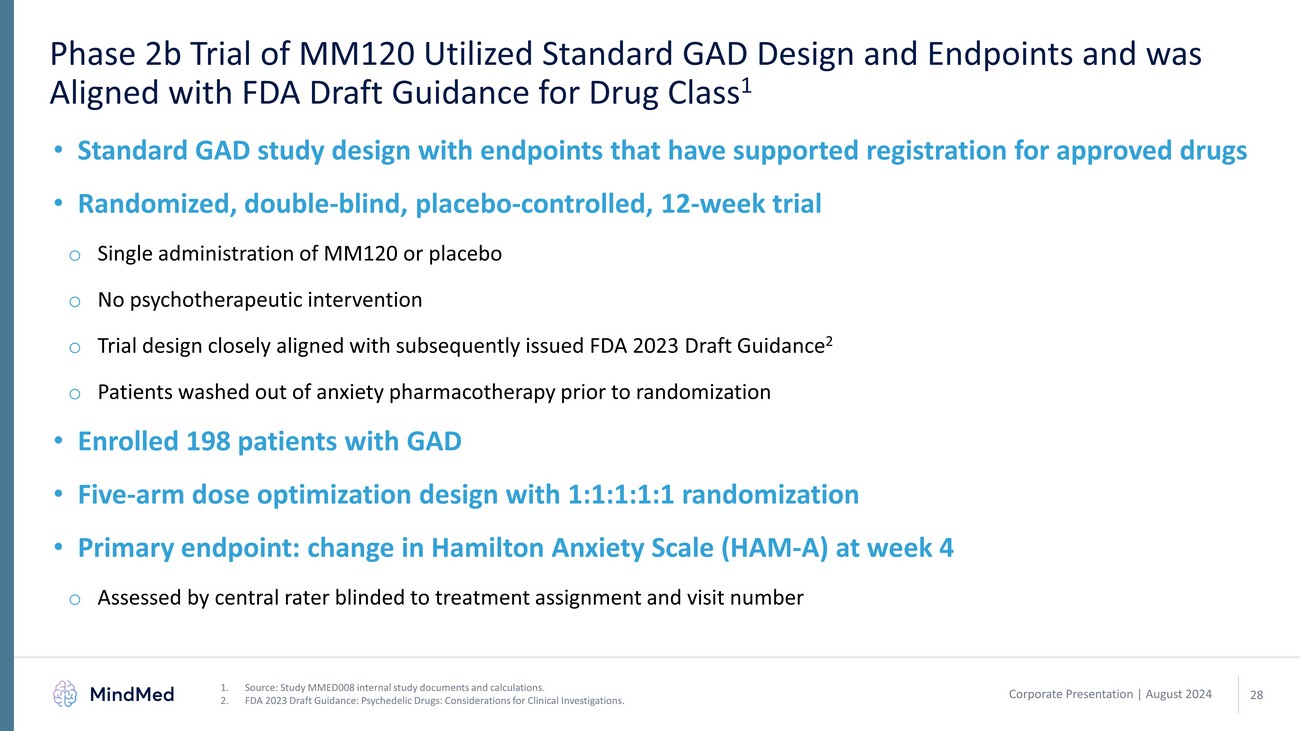
Corporate Presentation | August 2024 Phase 2b Trial of MM120 Utilized Standard GAD Design and Endpoints and was Aligned with FDA Draft Guidance for Drug Class 1 1. Source: Study MMED008 internal study documents and calculations. 2. FDA 2023 Draft Guidance: Psychedelic Drugs: Considerations for Clinical Investigations. 28 • Standard GAD study design with endpoints that have supported registration for approved drugs • Randomized, double - blind, placebo - controlled, 12 - week trial o Single administration of MM120 or placebo o No psychotherapeutic intervention o Trial design closely aligned with subsequently issued FDA 2023 Draft Guidance 2 o Patients washed out of anxiety pharmacotherapy prior to randomization • Enrolled 198 patients with GAD • Five - arm dose optimization design with 1:1:1:1:1 randomization • Primary endpoint: change in Hamilton Anxiety Scale (HAM - A) at week 4 o Assessed by central rater blinded to treatment assignment and visit numberDK0
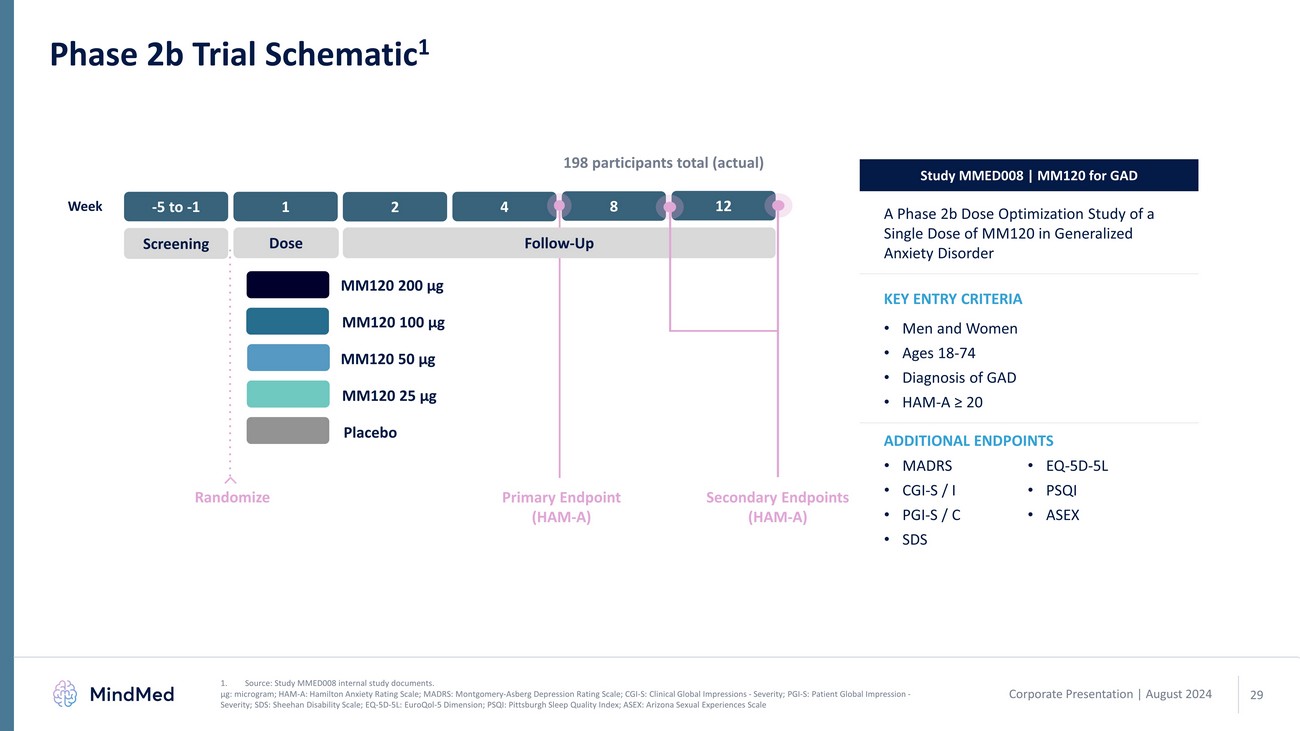
Corporate Presentation | August 2024 29 Phase 2b Trial Schematic 1 1. Source: Study MMED008 internal study documents. μ g: microgram; HAM - A: Hamilton Anxiety Rating Scale; MADRS: Montgomery - Asberg Depression Rating Scale; CGI - S: Clinical Global Impressions - Severity; PGI - S: Patient Global Impression - Severity; SDS: Sheehan Disability Scale; EQ - 5D - 5L: EuroQol - 5 Dimension; PSQI: Pittsburgh Sleep Quality Index; ASEX: Arizona Sexu al Experiences Scale Study MMED008 | MM120 for GAD • MADRS • CGI - S / I • PGI - S / C • SDS • EQ - 5D - 5L • PSQI • ASEX KEY ENTRY CRITERIA • Men and Women • Ages 18 - 74 • Diagnosis of GAD • HAM - A ≥ 20 A Phase 2b Dose Optimization Study of a Single Dose of MM120 in Generalized Anxiety Disorder ADDITIONAL ENDPOINTS 198 participants total (actual) Week Randomize Primary Endpoint (HAM - A) - 5 to - 1 1 2 4 8 12 MM120 200 µg MM120 1 00 µg MM120 50 µg MM120 25 µg Placebo Screening Dose Follow - Up Secondary Endpoints (HAM - A)
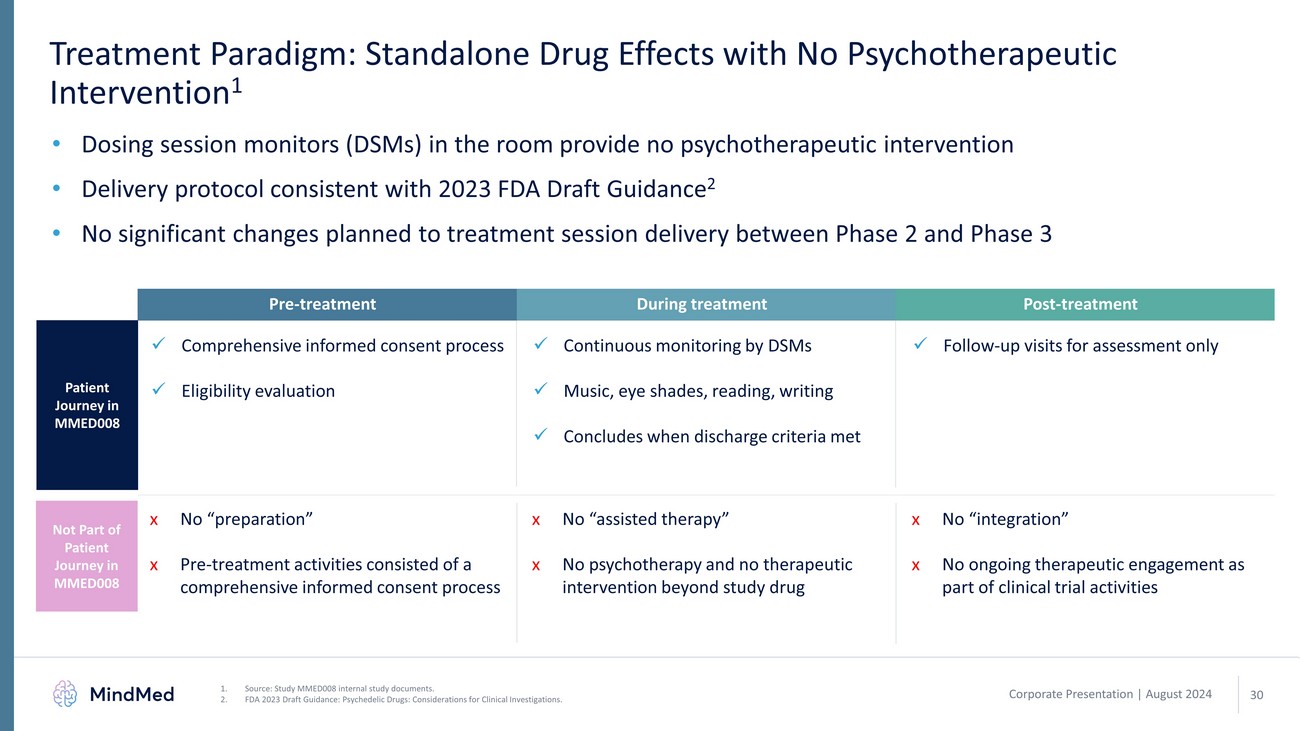
Corporate Presentation | August 2024 Treatment Paradigm: Standalone Drug Effects with No Psychotherapeutic Intervention 1 1. Source: Study MMED008 internal study documents. 2. FDA 2023 Draft Guidance: Psychedelic Drugs: Considerations for Clinical Investigations. • Dosing session monitors (DSMs) in the room provide no psychotherapeutic intervention • Delivery protocol consistent with 2023 FDA Draft Guidance 2 • No significant changes planned to treatment session delivery between Phase 2 and Phase 3 Patient Journey in MMED008 x Comprehensive informed consent process x Eligibility evaluation x Continuous monitoring by DSMs x Music, eye shades, reading, writing x Concludes when discharge criteria met x Follow - up visits for assessment only Pre - treatment During treatment Post - treatment Not Part of Patient Journey in MMED008 x No “preparation” x Pre - treatment activities consisted of a comprehensive informed consent process x No “assisted therapy” x No psychotherapy and no therapeutic intervention beyond study drug x No “integration” x No ongoing therapeutic engagement as part of clinical trial activities 30
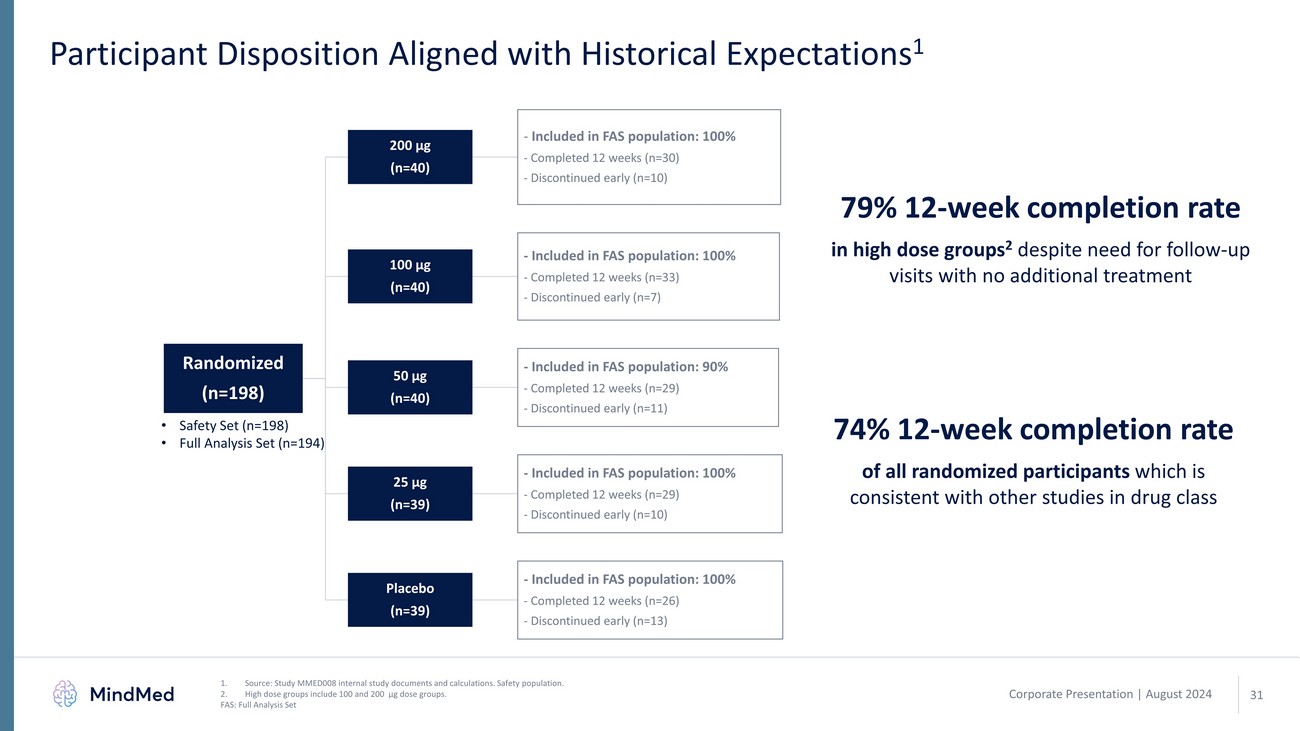
Corporate Presentation | August 2024 31 Participant Disposition Aligned with Historical Expectations 1 1. Source: Study MMED008 internal study documents and calculations. Safety population. 2. High dose groups include 100 and 200 µg dose groups. FAS: Full Analysis Set Randomized (n=198) 200 µg (n=40) - Included in FAS population: 100% - Completed 12 weeks (n=30) - Discontinued early (n=10) 100 µg (n=40) - Included in FAS population: 100% - Completed 12 weeks (n=33) - Discontinued early (n=7) 50 µg (n=40) - Included in FAS population: 90% - Completed 12 weeks (n=29) - Discontinued early (n=11) 25 µg (n=39) - Included in FAS population: 100% - Completed 12 weeks (n=29) - Discontinued early (n=10) Placebo (n=39) - Included in FAS population: 100% - Completed 12 weeks (n=26) - Discontinued early (n=13) 74% 12 - week completion rate of all randomized participants which is consistent with other studies in drug class 79% 12 - week completion rate in high dose groups 2 despite need for follow - up visits with no additional treatment • Safety Set (n=198) • Full Analysis Set (n=194)

Corporate Presentation | August 2024 32 Participant Demographics and Baseline Characteristics Generally Balanced Across Groups 1 1. Source: Study MMED008 internal study documents and calculations. Full analysis set population. Demographic (n=194) MM120 Placebo 25 µg (n=39) 50 µg (n=36) 100 µg (n=40) 200 µg (n=40) (n=39) Mean age (years) 38.0 45.3 42.7 42.1 38.7 Sex, female (%) 51.3% 55.6% 40.0% 70.0% 66.7% Race (% white) 84.6% 80.6% 90.0% 82.5% 76.9% Baseline HAM - A score 30.2 30.3 29.3 31.0 30.3 Baseline CGI - S score 4.9 4.9 4.8 5.1 4.9
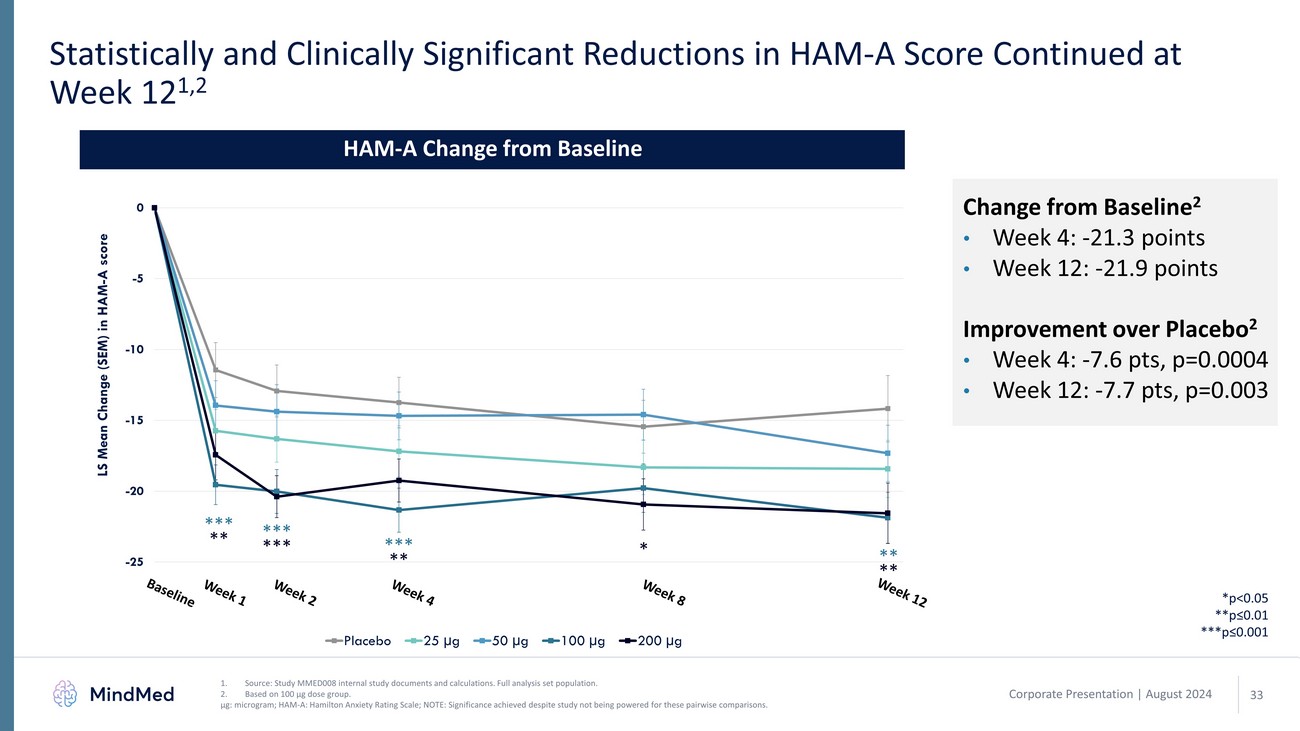
Corporate Presentation | August 2024 -25 -20 -15 -10 -5 0 LS Mean Change (SEM) in HAM - A score Placebo 25 µg 50 µg 100 µg 200 µg HAM - A Change from Baseline 33 Statistically and Clinically Significant Reductions in HAM - A Score Continued at Week 12 1,2 1. Source: Study MMED008 internal study documents and calculations. Full analysis set population. 2. Based on 100 µg dose group. μ g: microgram; HAM - A: Hamilton Anxiety Rating Scale; NOTE: Significance achieved despite study not being powered for these pairwi se comparisons. *p<0.05 **p≤0.01 ***p≤0.001 Change from Baseline 2 • Week 4: - 21.3 points • Week 12: - 21.9 points Improvement over Placebo 2 • Week 4: - 7.6 pts, p=0.0004 • Week 12: - 7.7 pts, p=0.003 *** ** *** *** *** ** * ** **DK0
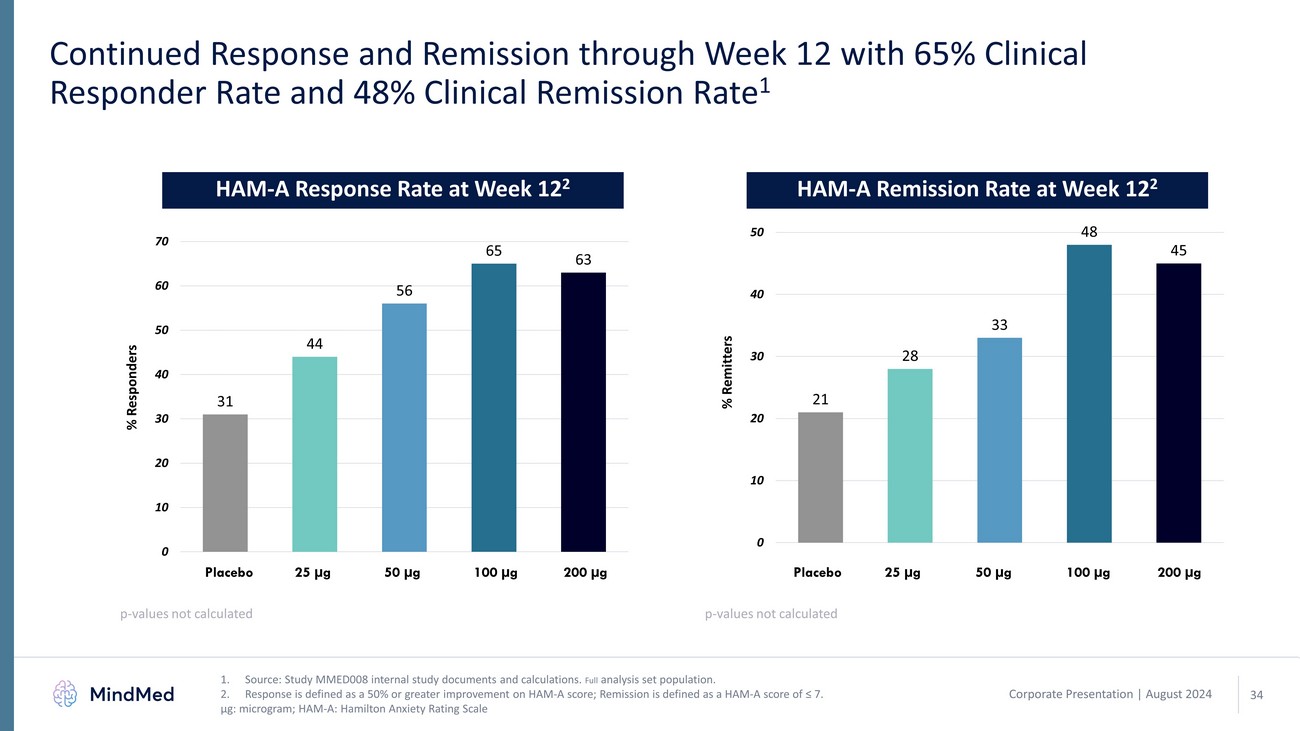
Corporate Presentation | August 2024 HAM - A Remission Rate at Week 12 2 HAM - A Response Rate at Week 12 2 34 Continued Response and Remission through Week 12 with 65% Clinical Responder Rate and 48% Clinical Remission Rate 1 1. Source: Study MMED008 internal study documents and calculations. Full analysis set population. 2. Response is defined as a 50% or greater improvement on HAM - A score; Remission is defined as a HAM - A score of ≤ 7. μ g: microgram; HAM - A: Hamilton Anxiety Rating Scale Placebo 25 µg 50 µg 100 µg 200 µg Placebo 25 µg 50 µg 100 µg 200 µg p - values not calculated p - values not calculated 31 44 56 65 63 0 10 20 30 40 50 60 70 % Responders 21 28 33 48 45 0 10 20 30 40 50 % RemittersDK0
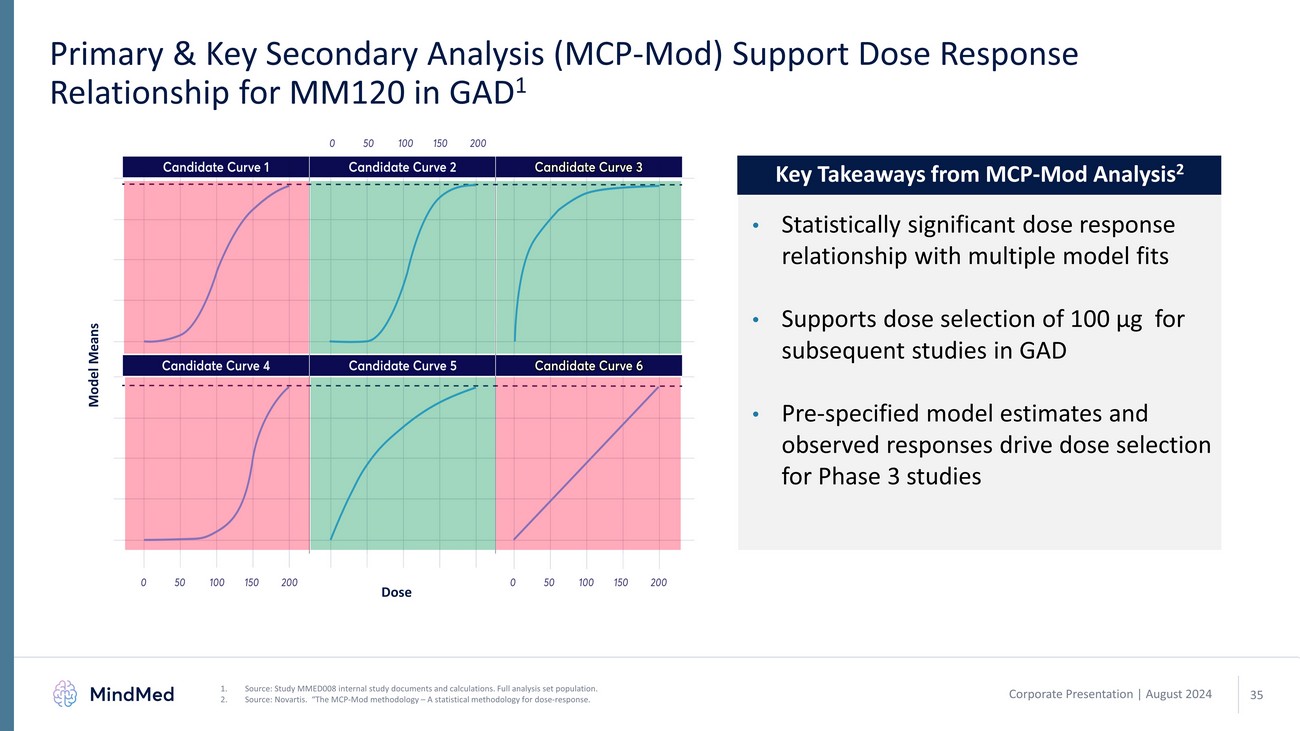
Corporate Presentation | August 2024 35 Primary & Key Secondary Analysis (MCP - Mod) Support Dose Response Relationship for MM120 in GAD 1 1. Source: Study MMED008 internal study documents and calculations. Full analysis set population. 2. Source: Novartis. “The MCP - Mod methodology – A statistical methodology for dose - response. • Statistically significant dose response relationship with multiple model fits • Supports dose selection of 100 µg for subsequent studies in GAD • Pre - specified model estimates and observed responses drive dose selection for Phase 3 studies Key Takeaways from MCP - Mod Analysis 2 Dose Model Means
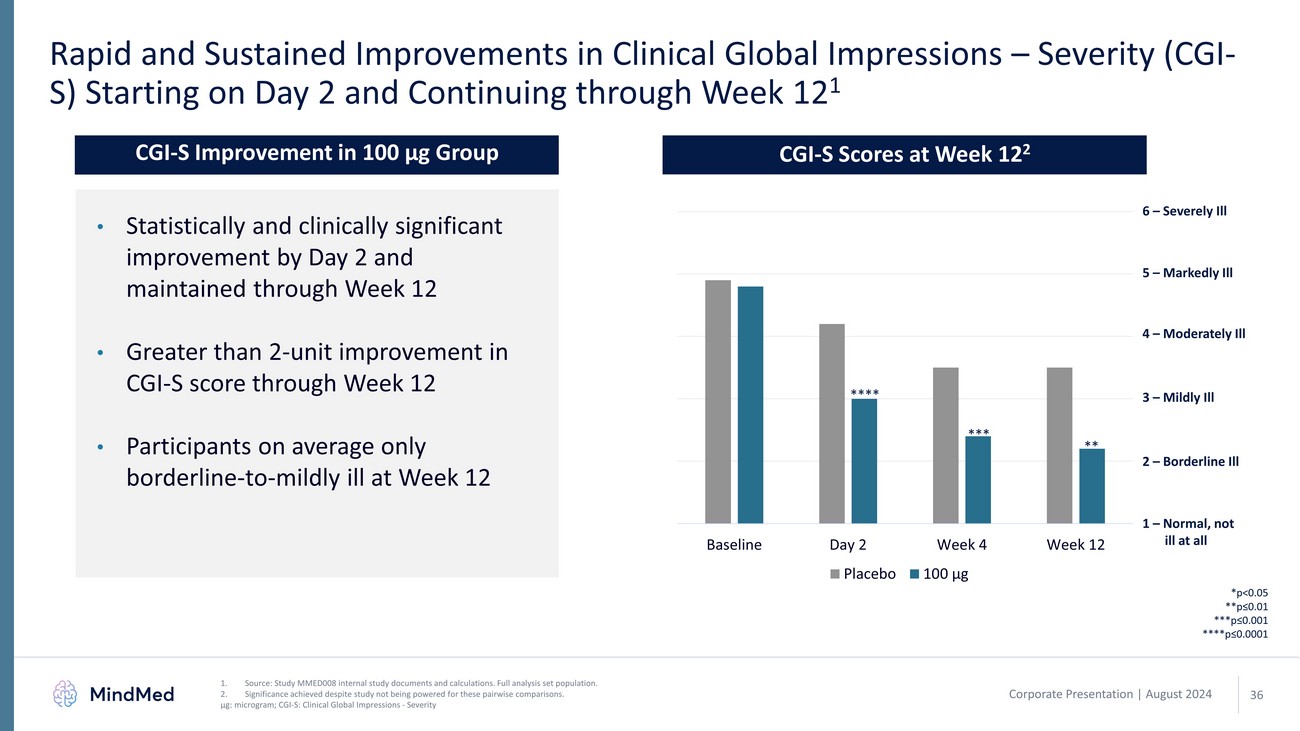
Corporate Presentation | August 2024 CGI - S Scores at Week 12 2 36 Rapid and Sustained Improvements in Clinical Global Impressions – Severity (CGI - S) Starting on Day 2 and Continuing through Week 12 1 1. Source: Study MMED008 internal study documents and calculations. Full analysis set population. 2. Significance achieved despite study not being powered for these pairwise comparisons. μ g: microgram; CGI - S: Clinical Global Impressions - Severity • Statistically and clinically significant improvement by Day 2 and maintained through Week 12 • Greater than 2 - unit improvement in CGI - S score through Week 12 • Participants on average only borderline - to - mildly ill at Week 12 6 – Severely Ill 5 – Markedly Ill 4 – Moderately Ill 3 – Mildly Ill 2 – Borderline Ill 1 – Normal, not ill at all CGI - S Improvement in 100 µg Group Baseline Day 2 Week 4 Week 12 Placebo 100 µg *p<0.05 **p≤0.01 ***p≤0.001 ****p≤0.0001 **** *** **DK0
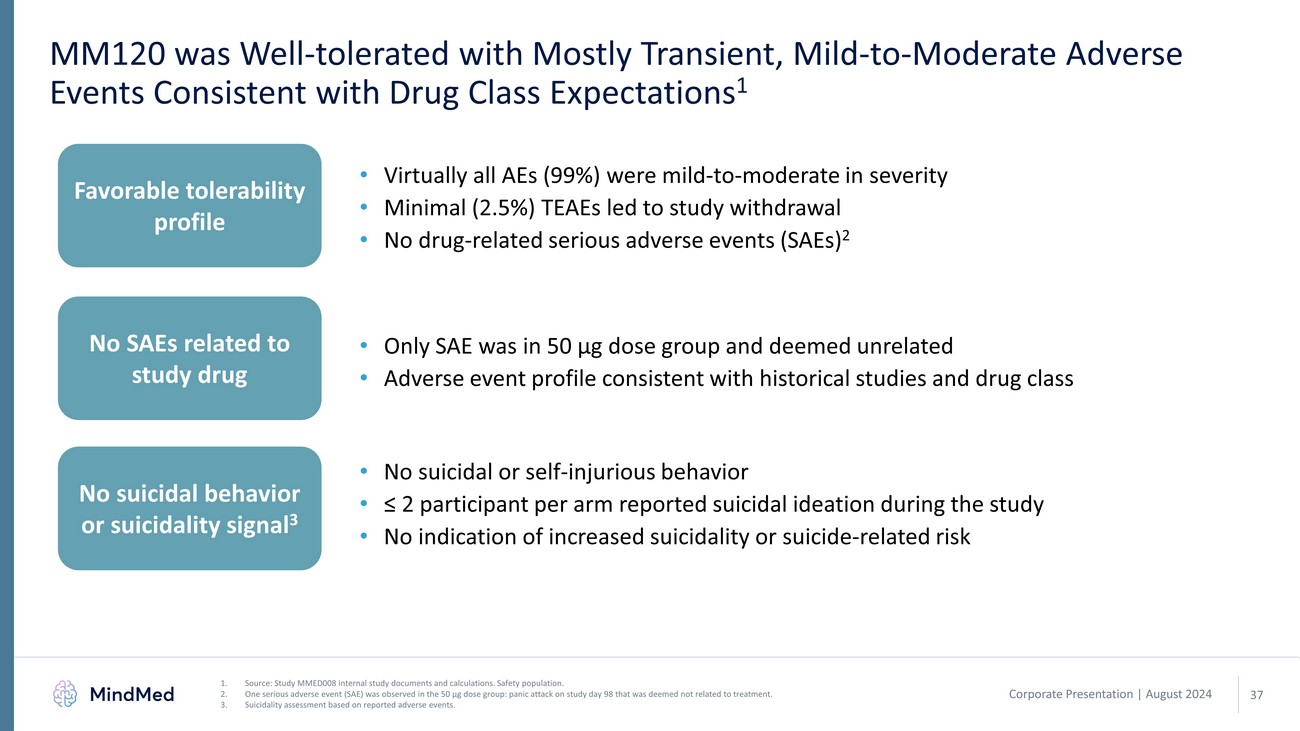
Corporate Presentation | August 2024 37 MM120 was Well - tolerated with Mostly Transient, Mild - to - Moderate Adverse Events Consistent with Drug Class Expectations 1 1. Source: Study MMED008 internal study documents and calculations. Safety population. 2. One serious adverse event (SAE) was observed in the 50 µg dose group: panic attack on study day 98 that was deemed not relate d t o treatment. 3. Suicidality assessment based on reported adverse events. • Virtually all AEs (99%) were mild - to - moderate in severity • Minimal (2.5%) TEAEs led to study withdrawal • No drug - related serious adverse events (SAEs) 2 Favorable tolerability profile No SAEs related to study drug No suicidal behavior or suicidality signal 3 • Only SAE was in 50 µg dose group and deemed unrelated • Adverse event profile consistent with historical studies and drug class • No suicidal or self - injurious behavior • ≤ 2 participant per arm reported suicidal ideation during the study • No indication of increased suicidality or suicide - related risk
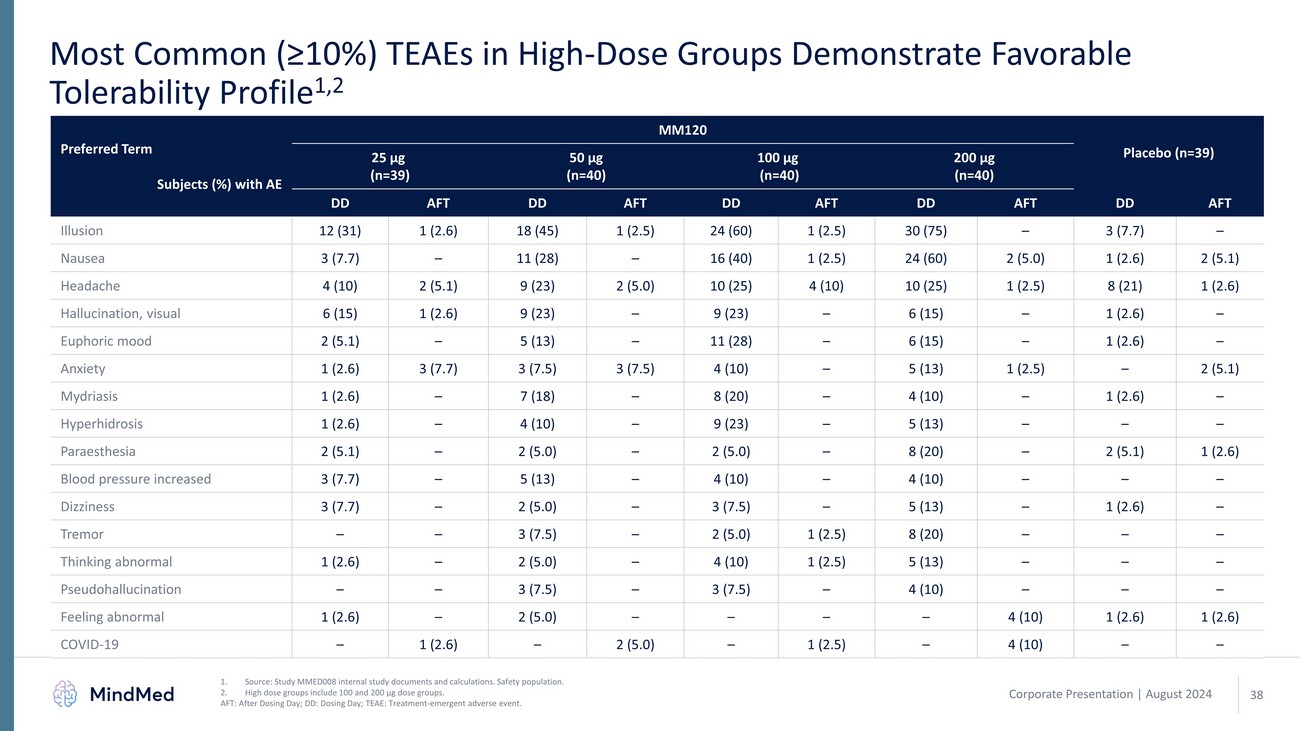
Corporate Presentation | August 2024 38 Most Common (≥10%) TEAEs in High - Dose Groups Demonstrate Favorable Tolerability Profile 1,2 1. Source: Study MMED008 internal study documents and calculations. Safety population. 2. High dose groups include 100 and 200 µg dose groups. AFT: After Dosing Day; DD: Dosing Day; TEAE: Treatment - emergent adverse event. Preferred Term Subjects (%) with AE MM120 Placebo (n=39) 25 µg (n=39) 50 µg (n=40) 100 µg (n=40) 200 µg (n=40) DD AFT DD AFT DD AFT DD AFT DD AFT Illusion 12 (31) 1 (2.6) 18 (45) 1 (2.5) 24 (60) 1 (2.5) 30 (75) – 3 (7.7) – Nausea 3 (7.7) – 11 (28) – 16 (40) 1 (2.5) 24 (60) 2 (5.0) 1 (2.6) 2 (5.1) Headache 4 (10) 2 (5.1) 9 (23) 2 (5.0) 10 (25) 4 (10) 10 (25) 1 (2.5) 8 (21) 1 (2.6) Hallucination, visual 6 (15) 1 (2.6) 9 (23) – 9 (23) – 6 (15) – 1 (2.6) – Euphoric mood 2 (5.1) – 5 (13) – 11 (28) – 6 (15) – 1 (2.6) – Anxiety 1 (2.6) 3 (7.7) 3 (7.5) 3 (7.5) 4 (10) – 5 (13) 1 (2.5) – 2 (5.1) Mydriasis 1 (2.6) – 7 (18) – 8 (20) – 4 (10) – 1 (2.6) – Hyperhidrosis 1 (2.6) – 4 (10) – 9 (23) – 5 (13) – – – Paraesthesia 2 (5.1) – 2 (5.0) – 2 (5.0) – 8 (20) – 2 (5.1) 1 (2.6) Blood pressure increased 3 (7.7) – 5 (13) – 4 (10) – 4 (10) – – – Dizziness 3 (7.7) – 2 (5.0) – 3 (7.5) – 5 (13) – 1 (2.6) – Tremor – – 3 (7.5) – 2 (5.0) 1 (2.5) 8 (20) – – – Thinking abnormal 1 (2.6) – 2 (5.0) – 4 (10) 1 (2.5) 5 (13) – – – Pseudohallucination – – 3 (7.5) – 3 (7.5) – 4 (10) – – – Feeling abnormal 1 (2.6) – 2 (5.0) – – – – 4 (10) 1 (2.6) 1 (2.6) COVID - 19 – 1 (2.6) – 2 (5.0) – 1 (2.5) – 4 (10) – –PJ0
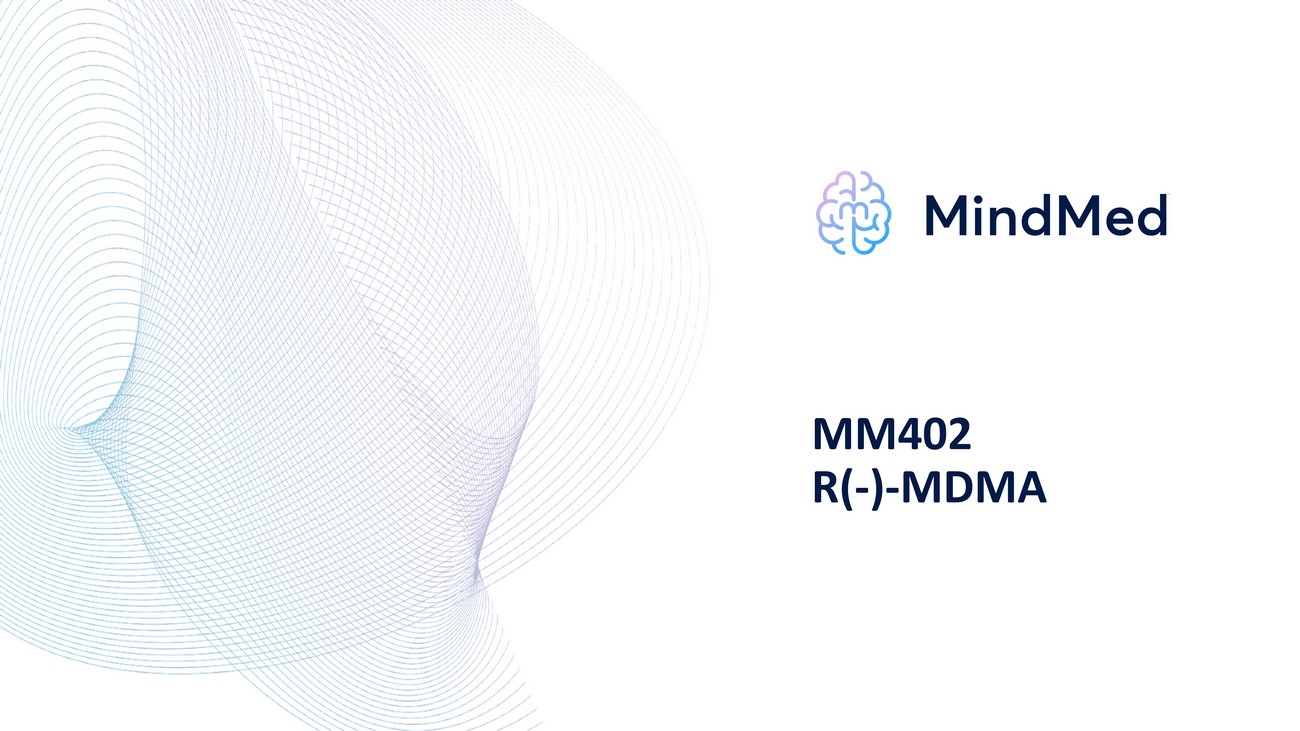
MM402 R( - ) - MDMA
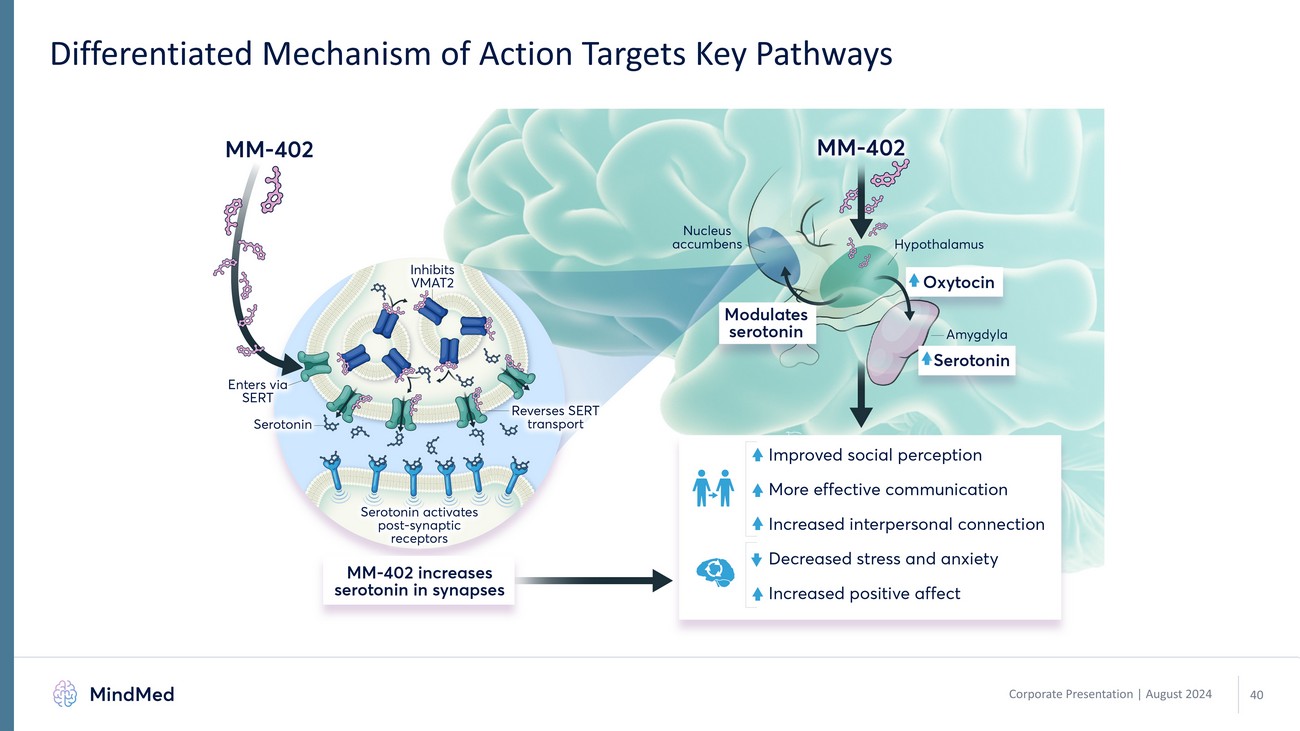
Corporate Presentation | August 2024 Differentiated Mechanism of Action Targets Key Pathways 40
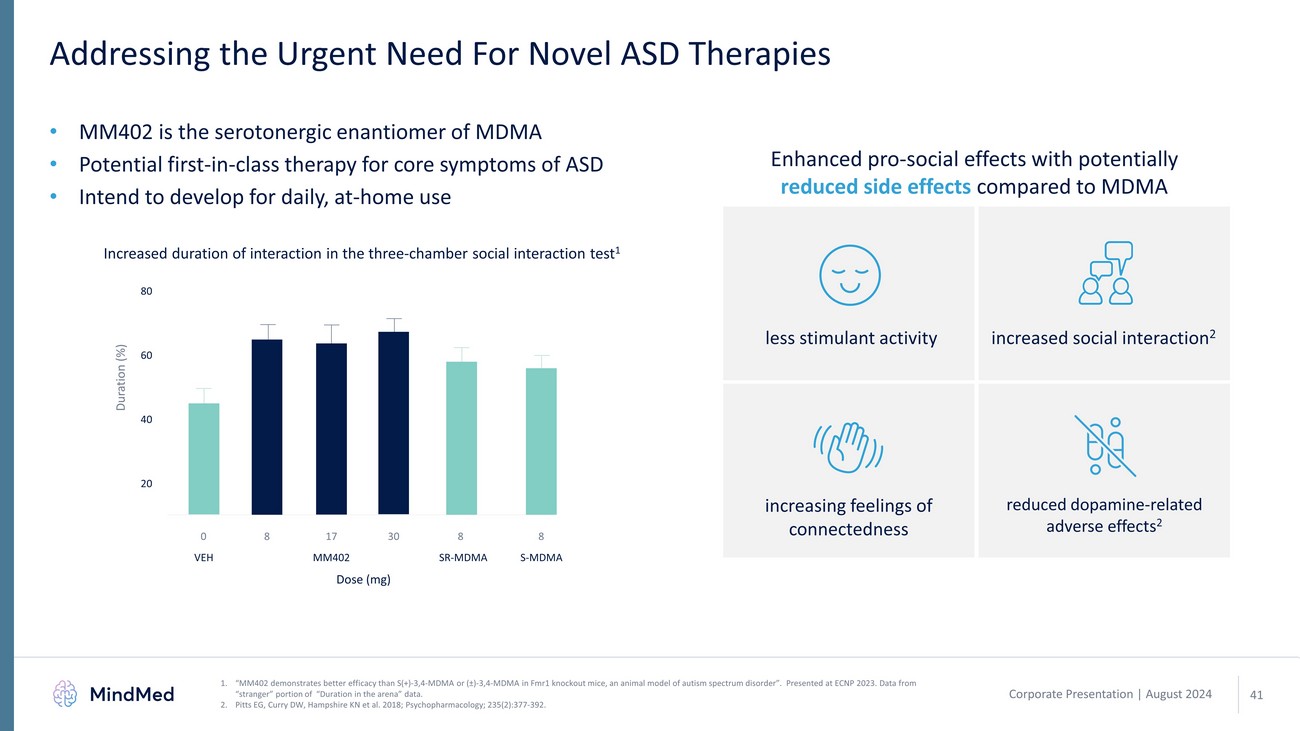
Corporate Presentation | August 2024 increasing feelings of connectedness • MM402 is the serotonergic enantiomer of MDMA • Potential first - in - class therapy for core symptoms of ASD • Intend to develop for daily, at - home use reduced dopamine - related adverse effects 2 Enhanced pro - social effects with potentially reduced side effects compared to MDMA less stimulant activity increased social interaction 2 Addressing the Urgent Need For Novel ASD Therapies 1. “MM402 demonstrates better efficacy than S(+) - 3,4 - MDMA or ( ± ) - 3,4 - MDMA in Fmr1 knockout mice, an animal model of autism spectrum disorder”. Presented at ECNP 2023. Data from “stranger” portion of “Duration in the arena” data. 2. Pitts EG, Curry DW, Hampshire KN et al. 2018; Psychopharmacology; 235(2):377 - 392. Duration (%) VEH S - MDMA Dose (mg) 20 40 60 80 MM402 SR - MDMA 0 8 17 30 8 8 Increased duration of interaction in the three - chamber social interaction test 1 41
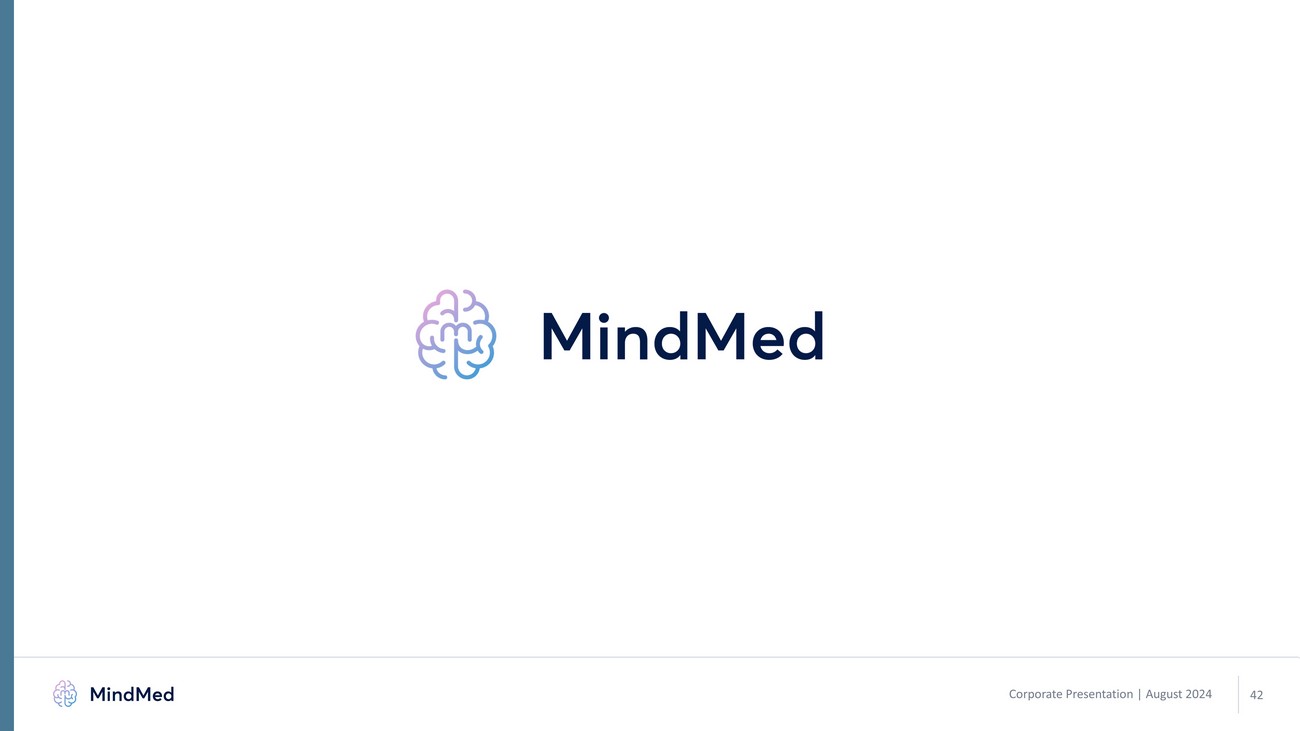
Corporate Presentation | August 2024 42

Appendix
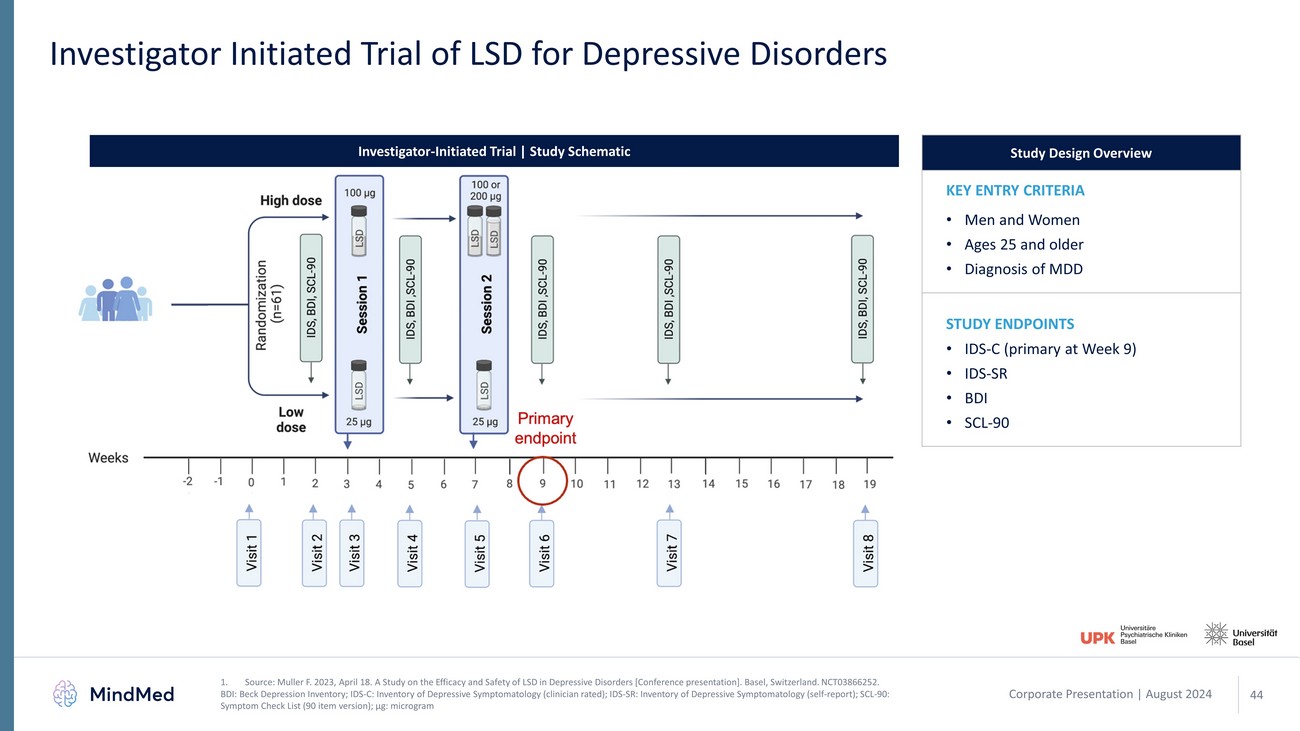
Corporate Presentation | August 2024 Investigator Initiated Trial of LSD for Depressive Disorders 1. Source: Muller F. 2023, April 18. A Study on the Efficacy and Safety of LSD in Depressive Disorders [Conference presentation] . B asel, Switzerland. NCT03866252. BDI: Beck Depression Inventory; IDS - C: Inventory of Depressive Symptomatology (clinician rated); IDS - SR: Inventory of Depressive Symptomatology (self - report); SCL - 90: Symptom Check List (90 item version); μ g: microgram 44 Investigator - Initiated Trial | Study Schematic Study Design Overview • IDS - C (primary at Week 9) • IDS - SR • BDI • SCL - 90 KEY ENTRY CRITERIA • Men and Women • Ages 25 and older • Diagnosis of MDD STUDY ENDPOINTS
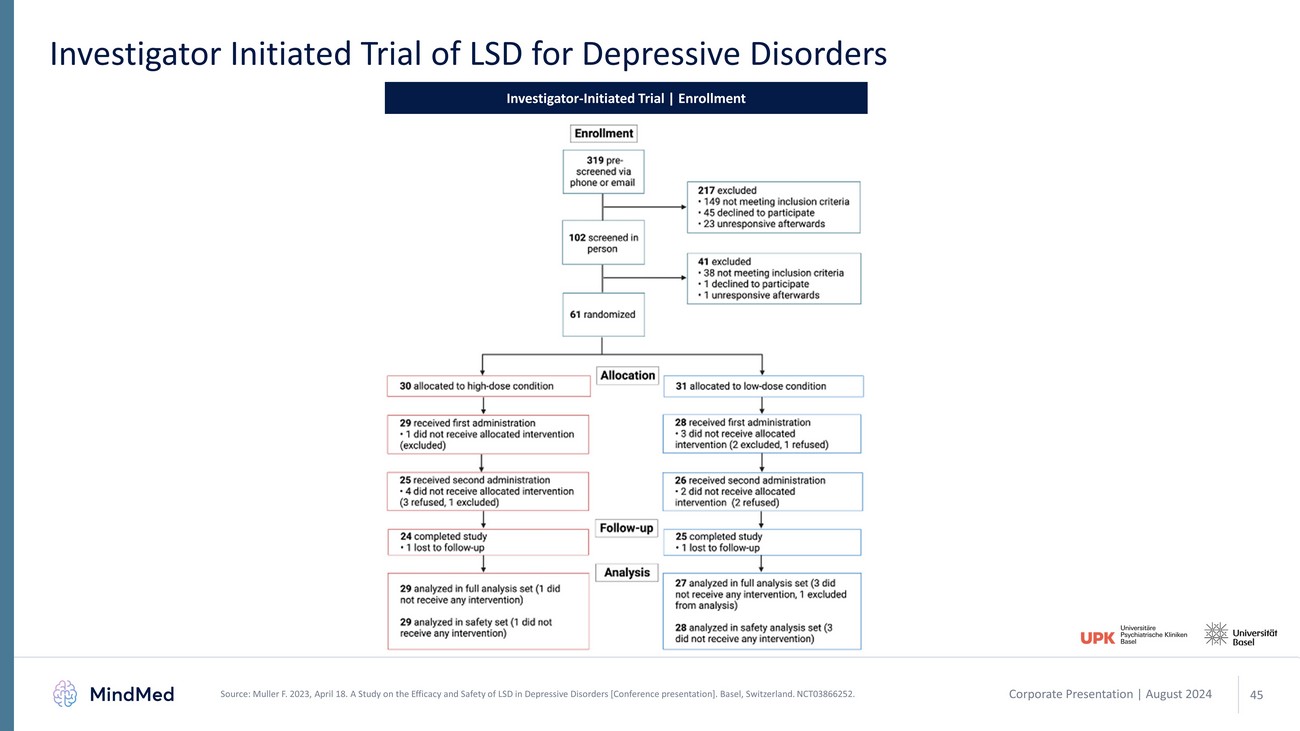
Corporate Presentation | August 2024 Investigator Initiated Trial of LSD for Depressive Disorders Source: Muller F. 2023, April 18. A Study on the Efficacy and Safety of LSD in Depressive Disorders [Conference presentation] . B asel, Switzerland. NCT03866252. 45 Investigator - Initiated Trial | Enrollment
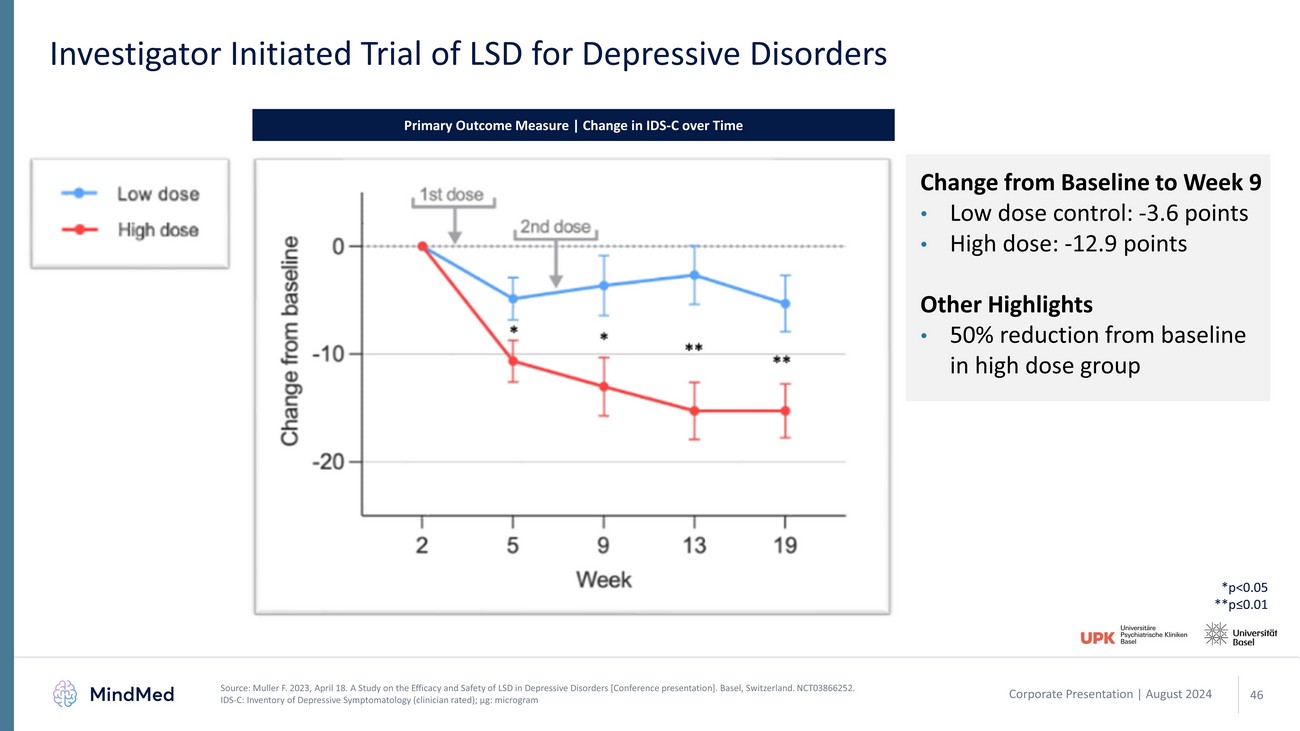
Corporate Presentation | August 2024 Investigator Initiated Trial of LSD for Depressive Disorders Source: Muller F. 2023, April 18. A Study on the Efficacy and Safety of LSD in Depressive Disorders [Conference presentation] . B asel, Switzerland. NCT03866252. IDS - C: Inventory of Depressive Symptomatology (clinician rated); μ g: microgram 46 Primary Outcome Measure | Change in IDS - C over Time *p<0.05 **p≤0.01 Change from Baseline to Week 9 • Low dose control: - 3.6 points • High dose: - 12.9 points Other Highlights • 50% reduction from baseline in high dose group
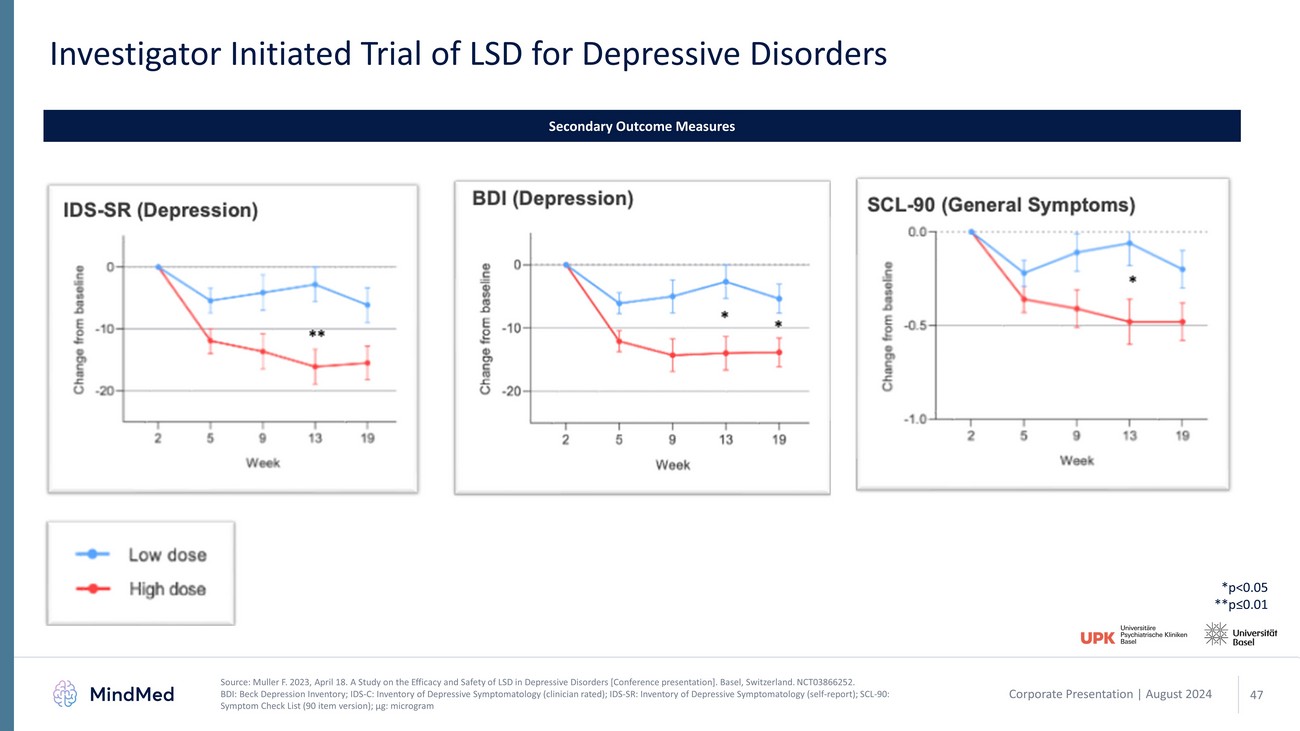
Corporate Presentation | August 2024 Investigator Initiated Trial of LSD for Depressive Disorders Source: Muller F. 2023, April 18. A Study on the Efficacy and Safety of LSD in Depressive Disorders [Conference presentation] . B asel, Switzerland. NCT03866252. BDI: Beck Depression Inventory; IDS - C: Inventory of Depressive Symptomatology (clinician rated); IDS - SR: Inventory of Depressive Symptomatology (self - report); SCL - 90: Symptom Check List (90 item version); μ g: microgram 47 Secondary Outcome Measures *p<0.05 **p≤0.01